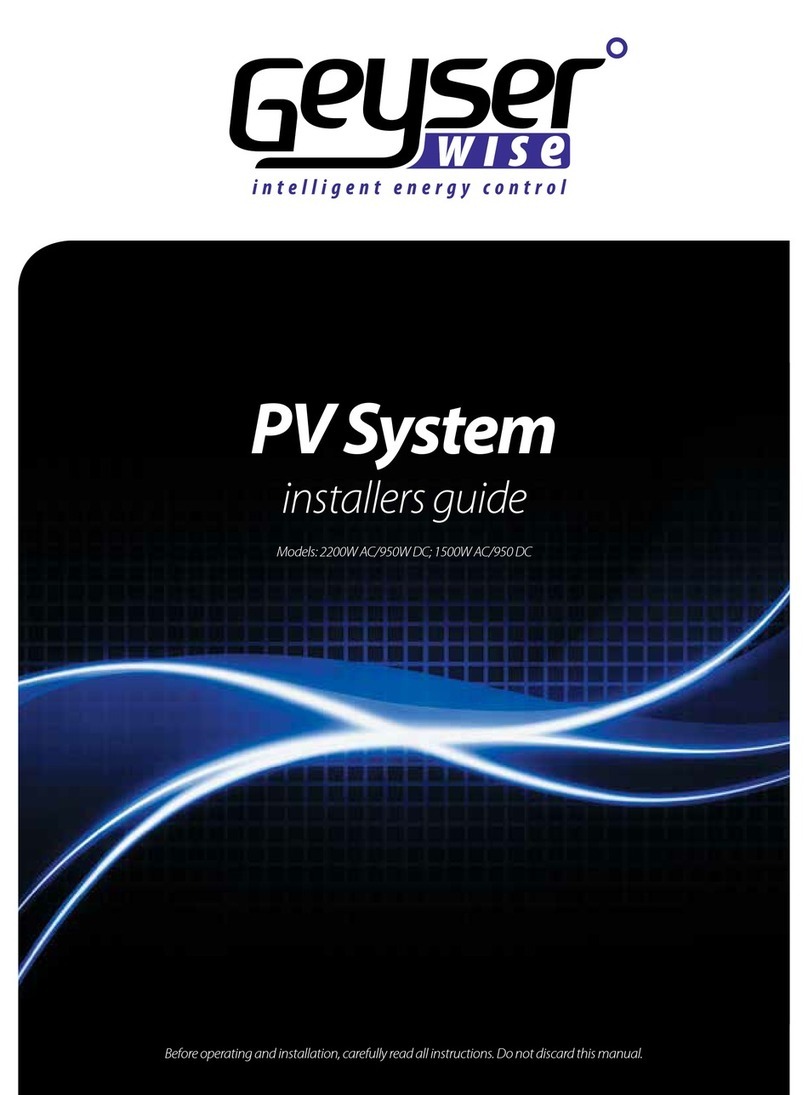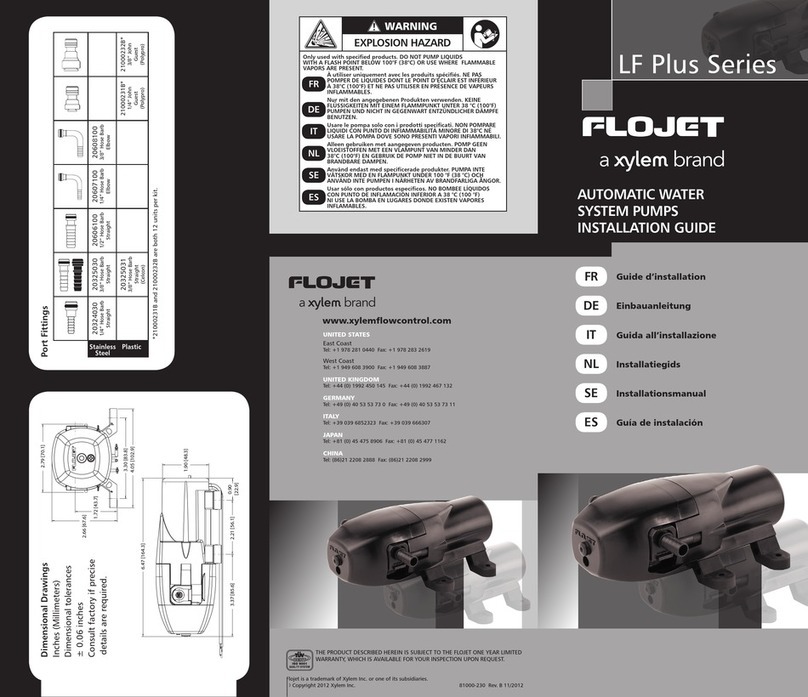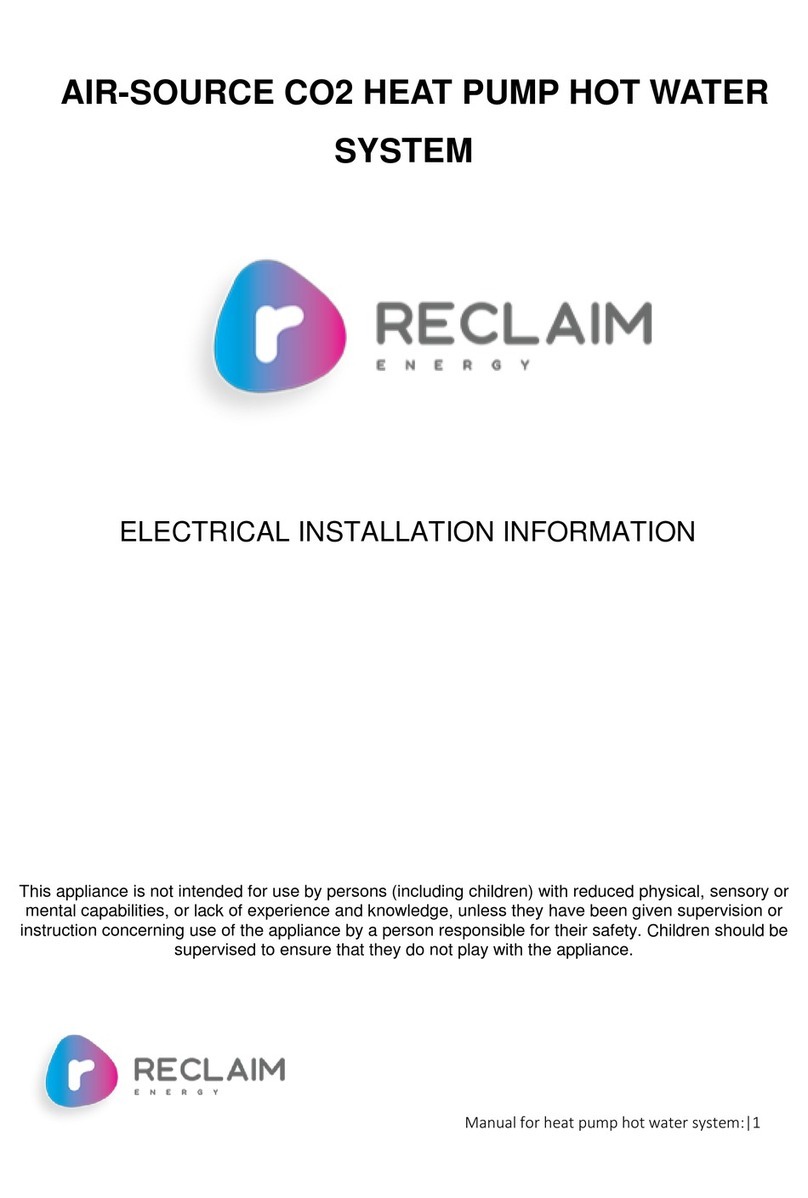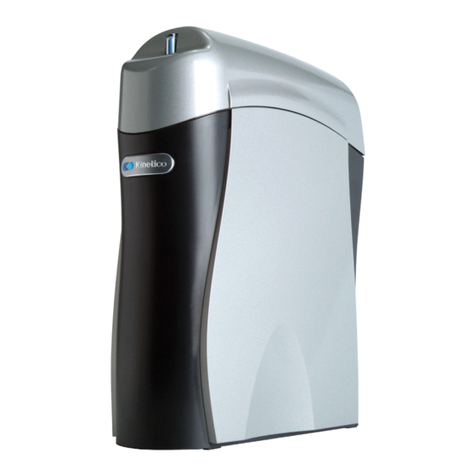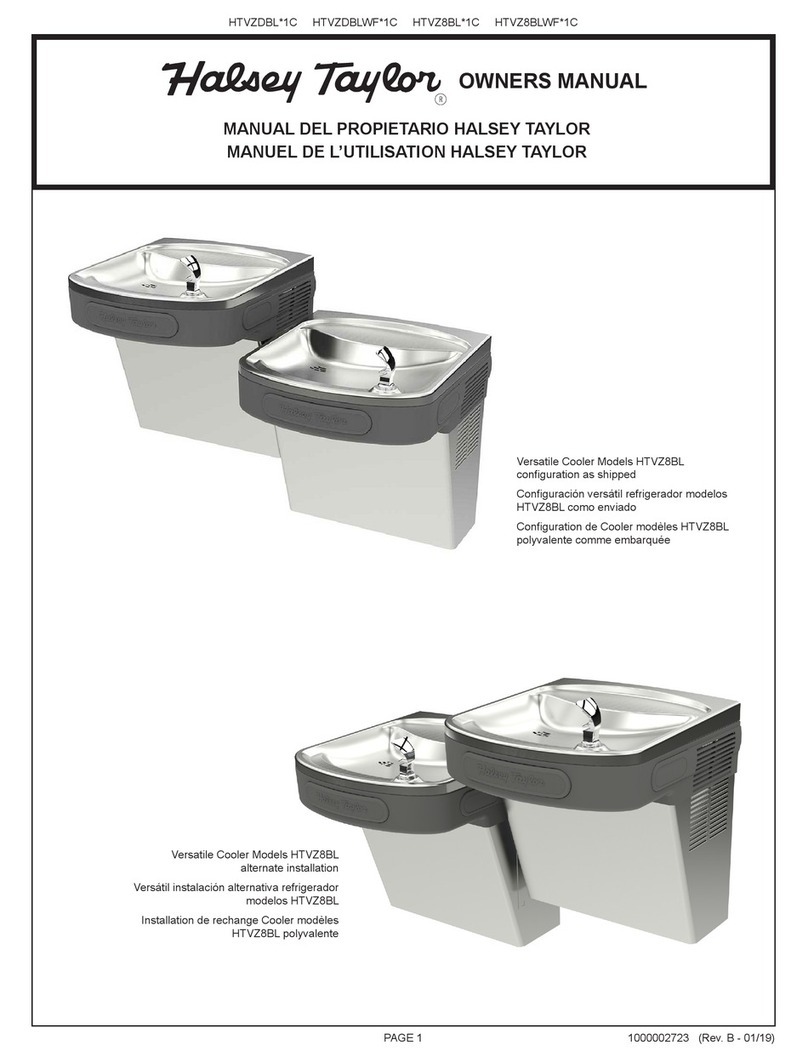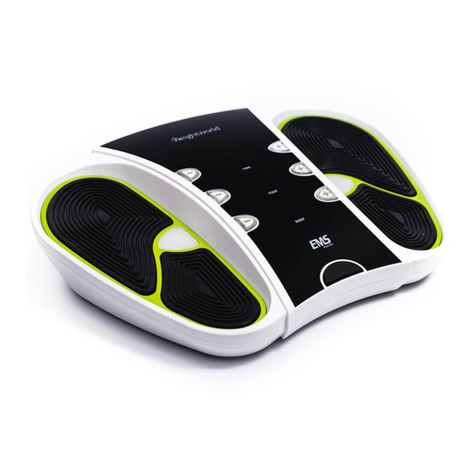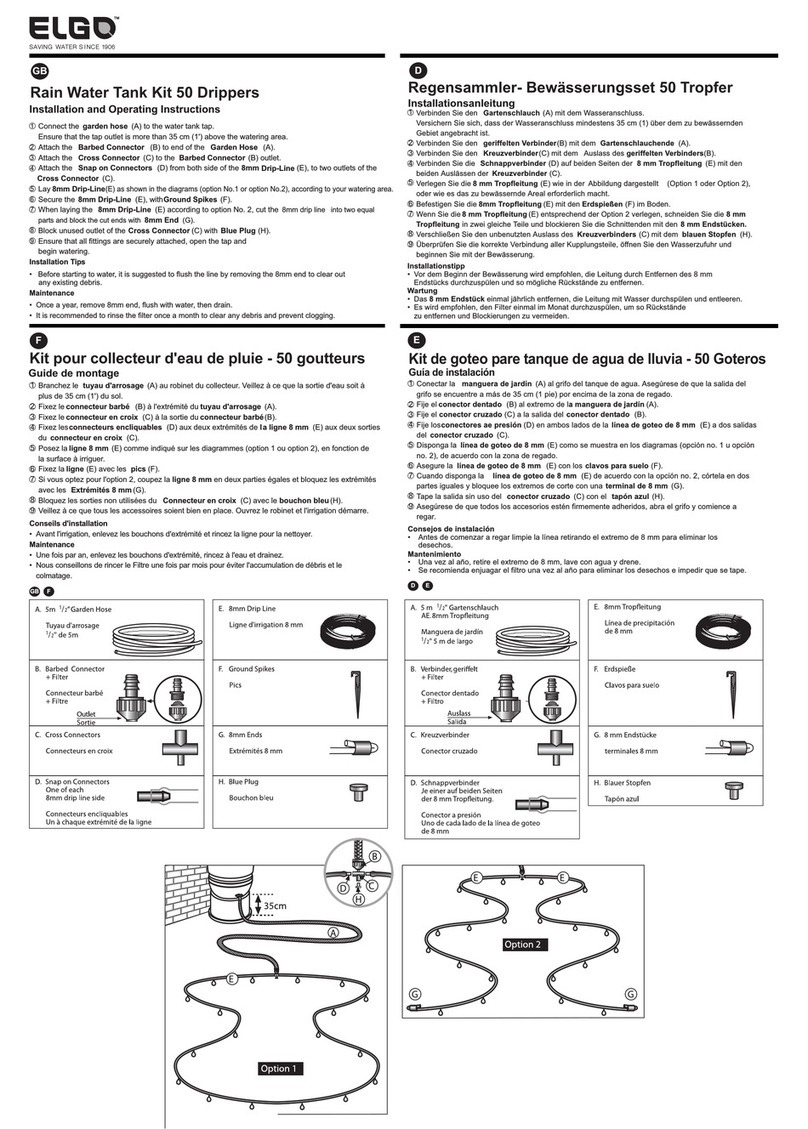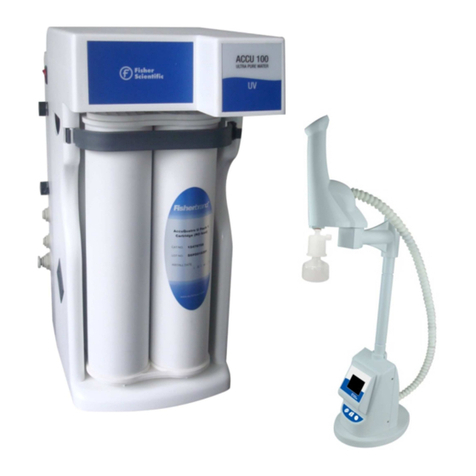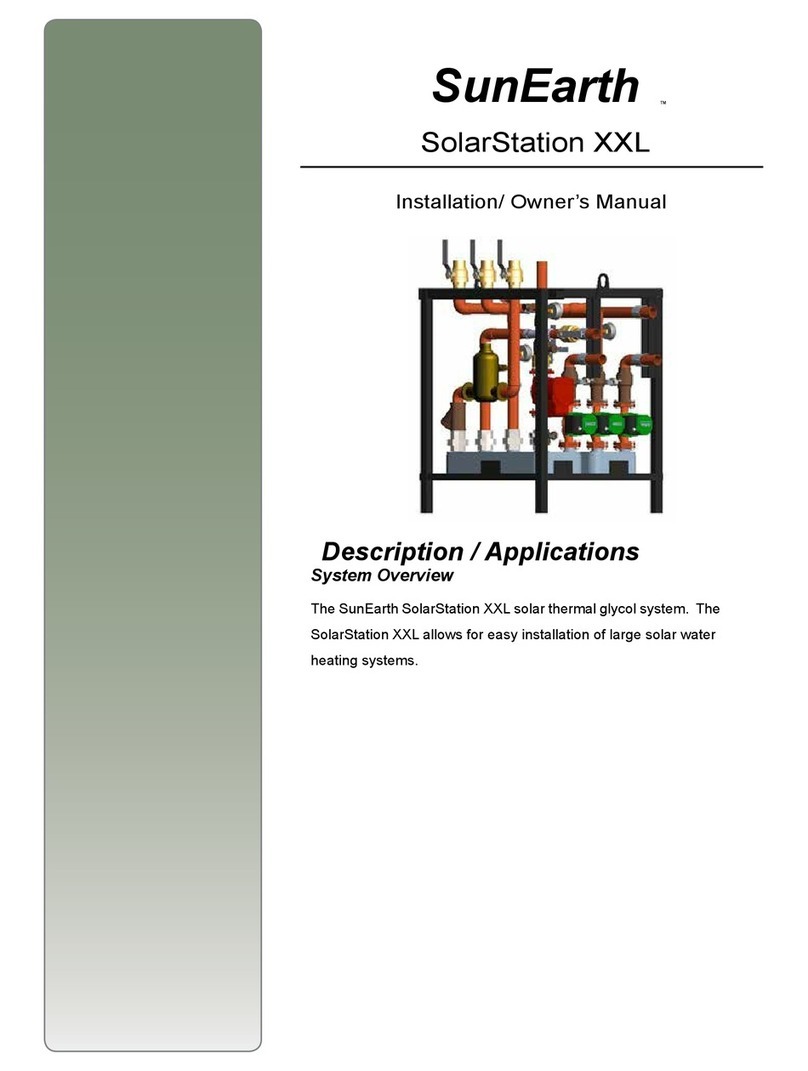GREENoneTEC TSC160 User manual

DE Handbuch
EN
I
F
E
Manual
Manuale
Manuel
Manual
30° 45°
160 200 300


3
30° 45°
Sicherheitshinweise......................................................... 5
Montagehinweise .......................................................... 6
Wartungshinweise......................................................... 10
SpezifikationWasserqualitäten ............................................... 35
Hydraulikdiagramm........................................................ 36
Mögliche Durchströmungsarten / Hydraulikdiagramm - Boiler........................... 37
HydraulischeAnschlüsseBoiler................................................ 38
Transporthinweis.......................................................... 39
AngabenzumKollektor ..................................................... 40
Werkzeugübersicht........................................................ 42
Materialübersicht - 160/200 . . ................................................ 43
Wiederkehrender Hinweis.................................................... 45
Flachdachmontage, 30/45° angehoben (160/200) .................................. 46
Materialübersicht-300..................................................... 54
Flachdachmontage, 30/45° angehoben (300) . . . . . . ................................ 56
BefüllendesThermosifonsystems.............................................. 62
ChecklistefürdieErstinbetriebnahme........................................... 63
691100430.0 / version 2018-11
Inhaltsverzeichnis
Contents
Indice
Table des matières
Contenido
Avvertenzeperlasicurezza .................................................. 17
Istruzionidimontaggio ..................................................... 18
Suggerimentiperlamanutenzione............................................. 22
Specifica qualità dell’acqua................................................... 35
Schema idraulico.......................................................... 36
Possibili tipi di flusso / Schema idraulico - Accumulatore . . . . . . ........................ 37
Collegamentiidraulicicaldaia................................................. 38
IndicazioniperilTrasporto................................................... 39
InformazionisulCollettore................................................... 40
Panoramicadegliutensili.................................................... 42
Panoramica dei materiali - 160/200............................................. 43
Notaricorrente........................................................... 45
Montaggio su tetti piani, inclinato a 30/45° (160/200)................................ 46
Panoramicadeimateriali-300................................................ 54
Montaggio su tetti piani, inclinato a 30/45° (300) . . . . . . ............................. 56
Riempireilsistemaatermosifone.............................................. 62
Listadicontrolloperlamessainfunzione ........................................ 67
Safety information ........................................................ 11
Assemblyinstructions...................................................... 12
Maintenanceinstructions.................................................... 16
Specificationwaterquality .................................................. 35
Hydraulicdiagram......................................................... 36
Possibleflowtypes/Hydraulicdiagram-tank..................................... 37
Hydraulicconnectiontank ................................................... 38
Transportnote ........................................................... 39
Information about the collector................................................ 40
Overviewoftools ......................................................... 42
Overview of materials - 160/200............................................... 43
Recurring note ........................................................... 45
Flat roof mounting, 30/45° elevation (160/200) . . . . . . .............................. 46
Overviewofmaterials-300.................................................. 54
Flat roof mounting, 30/45° elevation (300) ....................................... 56
Filling Instructions of the system .............................................. 62
Checklistforfirststart-up ................................................... 65
DE
EN
IT
DE EN IT FR ES

4
30° 45°
Inhaltsverzeichnis
Contents
Indice
Table des matières
Contenido
Instructionsdesécurité..................................................... 23
Instructionsdemontage .................................................... 24
Conseilsd‘entretien........................................................ 28
Spécificationqualitédel’eau ................................................. 35
Schémahydraulique ....................................................... 36
Typesd’écoulementpossibles/Schémahydraulique-Ballon........................... 37
Raccordshydrauliquesballon................................................. 38
Indicationspourletransport ................................................. 39
Indicationsportantsurlecapteur.............................................. 40
Vued’ensembledesoutils ................................................... 42
Vue d’ensemble du matériel - 160/200 .......................................... 43
Remarque récurrente....................................................... 45
Montage sur toit plat, inclinaison 30/45° (160/200) ................................. 46
Vue d’ensemble du matériel - 300.............................................. 54
Montage sur toit plat, inclinaison 30/45° (300)..................................... 56
Instructionpourleremplissageduthermosiphon................................... 62
Pointsàvérifierlorsdelamiseenservice........................................ 69
Advertenciasdeseguridad................................................... 29
Instruccionesdemontaje.................................................... 30
Consejosdemantenimiento.................................................. 34
Especificación alidad del agua................................................. 35
Esquemahidráulico........................................................ 36
Tiposdecirculaciónposibles/Esquemahidráulico-depósito........................... 37
Conexiones hidráulicas de la caldera depósito...................................... 38
Indicaciones para el Transporte................................................ 39
Datosdelcolector......................................................... 40
Vistageneraldelasherramientas.............................................. 42
Vista general de los materiales - 160/200 ........................................ 43
Indicación recurrente....................................................... 45
Montaje en tejados planos, inclinado 30/45° (160/200)............................... 46
Vista general de los materiales - 300............................................ 54
Montaje en tejados planos, inclinado 30/45° (300) . ................................. 56
Llenado del sistema termosifón................................................ 62
Checkinglistparalapuestaenmarcha.......................................... 71
FR
ES
DE EN IT FR ES

5
30° 45° Sicherheitshinweise
Safety information
Avvertenze per la sicurezza
Instructions de sécurité
Advertencias de seguridad
DE
Bei Dachmontagen vorschriftsmäßige personenunabhängi-
ge Absturzsicherungen oder Auffangeinrichtungen nach DIN
18338 Dachdeckungs- u. Dachdichtungsarbeiten und nach
DIN 18451 Gerüst- arbeiten mit Sicherheitsnetz unbedingt
vor Arbeits- beginn aufbauen! Bauarbeiterschutz-Verord-
QXQJ%*%/6RQVWLJHOlQGHUVSH]L¿VFKH
Vorschriften sind unbedingt einzuhalten!
Sicherheitsgeschirr möglichst oberhalb des Benutzers an-
schlagen. Sicherheitsgeschirr nur an tragfähigen Bauteilen
bzw. Anschlagpunkten befestigen!
Falls personenunabhängige Absturzsicherungen oder
Auffangvorrichtungen aus arbeitstechnischen Gründen nicht
vorhanden sind, sind Sicherheitsgeschirre zu verwenden!
Schadhafte Leitern nicht benutzen, z.B. angebrochene
Holme und Sprossen von Holzleitern, verbogene und an-
geknickte Metallleitern. Angebrochene Holme, Wangen und
6SURVVHQYRQ+RO]OHLWHUQQLFKWÀLFNHQ
Nur von autorisierten Prüfstellen gekennzeichnete und ge-
prüfte Sicherheitsgeschirre (Halte- oder Auffanggurte, Ver-
bindungsseile/bänder, Falldämpfer, Seilkürzer) verwenden.
Anlegeleiter sicher aufstellen. Richtigen Auf- stellungswin-
kel beachten (68 ° - 75 °). Anlegeleitern gegen Ausgleiten,
Umfallen, Abrutschen und Einsinken sichern, z.B. durch
Fußverbreiterungen, dem Untergrund angepasste Leiterfü-
ße, Einhänge- vorrichtungen.
Falls keine personenunabhängige Absturzsicherungen oder
Auffangvorrichtungen vorhanden sind, kann es ohne Benut-
zung von Sicherheitsgeschirren zu Abstürzen aus großen
Höhen und damit zu schweren oder tödlichen Verletzungen
kommen!
Leitern nur an sichere Stützpunkte anlehnen. Leitern im
Verkehrsbereich durch Absperrungen sichern.
Bei Verwendung von Anlegeleitern kann es zu gefährlichen
Stürzen kommen, wenn die Leiter einsinkt, wegrutscht oder
umfällt!
Das Berühren spannungsführender, elektrischer Freileitun-
gen kann tödliche Folgen haben.
In der Nähe spannungsführender, elektrischer Freileitungen,
bei denen ein Berühren möglich ist, nur arbeiten, wenn
– deren spannungsfreier Zustand hergestellt und für die
Dauer der Arbeit sichergestellt ist.
– die spannungsführenden Teile durch Abdecken oder
Anschranken geschützt sind.
– die Sicherheitsabstände nicht unterschritten werden.
Spannungsradius:
1 m bei .........................1000 Volt Spannung
3 m bei ..........1000 bis 11000 Volt Spannung
4 m bei ........11000 bis 22000 Volt Spannung
5 m bei ........22000 bis 38000 Volt Spannung
> 5 m bei unbekannter Spannungsgröße
Bei Bohrarbeiten und beim Hantieren mit Solarkollektoren
(Glasbruch) Schutzbrille tragen!
Bei Montage Sicherheitsschuhe tragen!
Bei der Kollektormontage und beim Hantieren Kollektoren
schnittsichere Arbeitshandschuhe tragen!
Es darf nur das vorgeschriebene Wärmeträgermedium
eingesetzt werden! Bei Montage Helm tragen!

6
30° 45°
Montagehinweise
Assembly instructions
Istruzioni di montaggio
Instructions de montage
Instrucciones de montaje
DE
1. Allgemeine Hinweise
Wir freuen uns, dass Sie sich für unser Produkt entschieden haben. Mit diesem qualitativ hochwertigen und leis-
tungsstarken Produkt haben Sie eine gute Wahl getroffen. Wir wünschen Ihnen eine reibungslose Montage und ei-
nen erfolgreichen Betrieb. Lesen Sie bitte diese Anleitung vor der Montage und Inbetriebnahme aufmerksam durch,
da sie wichtige Hinweise für die fachgerechte Installation sowie zur Sicherheit enthält.
Die Montageanleitung muss nach erfolgter Inbetriebnahme dem Endkunden übergeben werden. Wir möchten sie
darauf hinweisen, dass eine einwandfreie Funktion nur dann gewährleistest ist, wenn 1) Sie eine jährliche Wartung
durch fachkundige Personen durchführen lassen 2) die in diesem Manual angeführten Hinweise sowie 3) die ange-
führten Betriebsempfehlungen eingehalten werden.
1.1. Fachkundige Personen (Montage, Inbetriebnahme, Wartung und im Störungsfall)
$OVÄIDFKNXQGLJH3HUVRQHQ³JHOWHQDXVVFKOLHOLFKTXDOL¿]LHUWHXQG]HUWL¿]LHUWH,QVWDOODWHXUHEHL0RQWDJHYRQ(OHNWURNRPSRQHQ
ten: Elektriker) mit aktuell gültiger Gewerbezulassung. Sämtliche in dieser Montageanleitung angeführten Tätigkeiten dürfen
ausnahmslos nur von diesen fachkundigen Personen durchgeführt werden.
1.2. Allgemeine Lager & Transporthinweise
Die Systemkomponenten dürfen nicht ungeschützt im Freien gelagert werden. Besonders die Kollektoranschlüsse und die Be-/
Entlüftungsöffnungen sind vor Wassereintritt sowie vor Verschmutzungen wie Staubeintrag, etc. zu schützen.
Der Kollektor oder Speicher darf weder an den Anschlüssen noch an den Schraubgewinden hochgehoben werden. Vermeiden
6LH6W|HXQGPHFKDQLVFKH(LQÀVVHDXIGLH6\VWHPNRPSRQHQWHQLQVEHVRQGHUHDXIGDV6RODUJODVGLH.ROOHNWRUUFNZDQGGLH
Rohranschlüsse und den Speichermantel.
1.3. Allgemeine Montageanweisungen
Die Montage darf nur von fachkundigen Personen vorgenommen werden. Ausschließlich an solche fachkundigen Personen richten
sich sämtliche Ausführungen dieser Anleitung. Grundsätzlich ist zur Montage das mitgelieferte Material zu verwenden. Informie-
ren Sie sich vor der Montage und dem Betrieb der Sonnenkollektoranlage über die jeweils gültigen örtlichen Normen und Vor-
schriften.
1.4. Ertragsvorhersage
Modell TSC160
Wasserverbrauch 110 l 140 l 170 l
Standort Qd [MJ/y] QL [MJ/y] fsol [%] Qd [MJ/y] QL [MJ/y] fsol [%] Qd [MJ/y] QL [MJ/y] fsol [%]
Stockholm (59.6° N) 4441 2385 53.7 6107 2980 48.8 7772 3427 44.1
Würzburg (49.5° N) 4257 2418 56.8 5854 3056 52.2 7450 3561 47.8
Davos (46.8° N) 4820 3576 74.2 6628 4441 67.0 8435 5053 59.9
Athen (38.0° N) 3305 2898 87.7 4545 3750 82.5 5784 4471 77.3
Modell TSC200
Wasserverbrauch 140 l 170 l 200 l
Standort Qd [MJ/y] QL [MJ/y] fsol [%] Qd [MJ/y] QL [MJ/y] fsol [%] Qd [MJ/y] QL [MJ/y] fsol [%]
Stockholm (59.6° N) 6107 2876 47.1 7772 3295 42.4 9437 3605 38.2
Würzburg (49.5° N) 5854 2968 50.7 7450 3442 46.2 9047 3809 42.1
Davos (46.8° N) 6628 4262 64.3 8435 4825 57.2 10243 5224 51.0
Athen (38.0° N) 4545 3672 80.8 5784 4361 75.4 7023 4951 70.5
Modell TSC300
Wasserverbrauch 200 l 250 l 300 l
Standort Qd [MJ/y] QL [MJ/y] fsol [%] Qd [MJ/y] QL [MJ/y] fsol [%] Qd [MJ/y] QL [MJ/y] fsol [%]
Stockholm (59.6° N) 9437 5096 54.0 11103 5685 51.2 13878 6481 46.7
Würzburg (49.5° N) 9047 5175 57.2 10643 5800 54.5 13304 6692 50.3
Davos (46.8° N) 10243 7662 74.8 12050 8507 70.6 15063 9610 63.8
Athen (38.0° N) 7023 6166 87.8 8263 7015 84.9 10328 8262 80.0

7
30° 45° Montagehinweise
Assembly instructions
Istruzioni di montaggio
Instructions de montage
Instrucciones de montaje
DE
2. Montagehinweise
2.1. Systemausrichtung
Für die Installation der Thermosiphonanlage wird ein geeigneter Platz ohne Beschattung (z.B.: Bäume, Gebäude) während des
gesamten Jahres benötigt.
Für eine optimale Funktion des Thermosiphonsystems muss die Anlage auf der Nordhalbkugel bestmöglich gegen Süden, auf
der Südhalbkugel bestmöglich gegen Norden ausgerichtet werden. Das Thermosiphon System ist geeignet für eine Neigung von
mindestens 15 ° bis maximal 45 °. Abweichungen von den vorgeschriebenen Kollektorneigungen sind nicht zulässig! Das Ther-
mosiphon System darf nur mit gefüllten Solar- und Brauchwasserkreis und gesicherter Wasserabnahme der Sonneneinstrahlung
ausgesetzt werden. Die Sichtseite des Kollektors ist sonst vor Sonneneinstrahlung zu schützen.
2.2. Statik
'LH0RQWDJHGDUIQXUDXIDXVUHLFKHQGWUDJIlKLJHQ'DFKÀlFKHQE]Z8QWHUNRQVWUXNWLRQHQHUIROJHQ'LHVWDWLVFKH7UDJIlKLJNHLWGHV
'DFKHVE]ZGHU8QWHUNRQVWUXNWLRQLVWYRUGHU0RQWDJHGHV7KHUPRVLSKRQV\VWHPVEDXVHLWVDOOHQIDOOVGXUFK%HL]LHKXQJHLQHV6WD
tikers auf örtliche und regionale Gegebenheiten hin zu prüfen (siehe auch Gewichtsangaben). Dabei ist besonderes Augenmerk
DXIGLH+RO]*WHGHV8QWHUEDXVEH]JOLFKGHU+DOWEDUNHLWYRQ6FKUDXEYHUELQGXQJHQ]XU%HIHVWLJXQJGHV7KHUPRVLSKRQV\V
WHPV]XOHJHQ'LHEDXVHLWLJHhEHUSUIXQJGHV7KHUPRVLSKRQV\VWHPVJHPl(1E]ZJHPlGHQOlQGHUVSH]L¿VFKJHOWHQGHQ
Vorschriften ist besonders in schneereichen Gebieten mit hohen Windgeschwindigkeiten erforderlich. Dabei ist auch auf alle Be-
sonderheiten des Aufstellungsortes (Föhn, Düseneffekte, Wirbelbildung, etc.) einzugehen, welche lokal zu erhöhten Belastungen
führen können.
2.3. Hinweis Schrägdach
Die Montage eines Kollektorfeldes ist ein Eingriff in ein (bestehendes) Dach. Dacheindeckungen wie z. B. Ziegel, Schindel und
Schiefer, besonders ausgebaute und bewohnte Dachgeschosse bzw. unterschrittene Mindestdachneigungen erfordern (bezogen
auf die Eindeckung) als Sicherheit gegen das Eindringen von Wasser z.B. durch Winddruck und Flugschnee zusätzliche, bauseitige
0DQDKPHQZLH]%8QWHUVSDQQEDKQHQ8PHLQHhEHUODVWXQJGHU'DFKHLQGHFNXQJE]ZGHU'DFKDQELQGXQJEHL6WRFNVFKUDX
be) zu vermeiden, muss ab einer charakteristischen Schneelast Sk von > 1,25 kN/m² ein Metalldachziegel eingesetzt werden.
Es ist bei der Auswahl des Montageortes darauf zu achten, dass die maximal zulässigen Belastungen weder durch Schnee- oder
Windkräfte überschritten werden. Grundsätzlich sind Kollektorfelder so zu montieren, dass der Schnee auf den Kollektoren frei
abrutschen kann. Ein möglicher Schneerückstau durch Schneefanggitter (oder durch besondere Aufstellungssituationen) darf die
Kollektoren nicht erreichen. In einem Abstand von 0,5 m über der Kollektoroberkante sind Schneefänger zu montieren, damit
GHU.ROOHNWRUQLFKWDOV6FKQHHIlQJHUIXQJLHUW8PXQ]XOlVVLJH:LQGVRJODVWHQ]XYHUPHLGHQGUIHQGLH.ROOHNWRUHQQLFKWLQGHQ
Randzonen des Dachs (e/10 Randzonen gemäß EN1991, Mindestabstand jedoch 1 m) montiert werden. Vor allem bei Aufstän-
GHUXQJHQGDUIGLH.ROOHNWRUREHUNDQWHQLFKWEHUGHQ'DFK¿UVWKLQDXVUDJHQ'LH.ROOHNWRUHQGUIHQQLFKWXQWHUKDOEHLQHV+|KHQ
sprungs montiert werden, um überhöhte Lasten durch Anwehung oder Abrutschen des Schnees vom höher liegenden Dach auf
das Kollektorsystem zu vermeiden. Sollten aus diesem Grund am höherliegenden Dach Schneefänger montiert werden, so ist die
Statik dieses Daches zu überprüfen.
2.4. Hinweis Flachdachmontage
Die Montage eines Thermosiphonsystems ist ein Eingriff in ein (bestehendes) Dach, besonders ausgebaute und bewohnte Dach-
geschosse bzw. unterschrittene Mindestdachneigungen erfordern (bezogen auf die Eindeckung) als Sicherheit gegen das Eindrin-
JHQYRQ:DVVHU]%GXUFK:LQGGUXFNXQG)OXJVFKQHH]XVlW]OLFKHEDXVHLWLJH0DQDKPHQZLH]%8QWHUVSDQQEDKQHQ(VLVWEHL
der Auswahl des Montageortes darauf zu achten, dass die maximal zulässigen Belastungen weder durch Schnee- oder Windkräfte
EHUVFKULWWHQZHUGHQ8PXQ]XOlVVLJH:LQGVRJODVWHQ]XYHUPHLGHQGDUIGDV7KHUPRVLSKRQV\VWHPQLFKWLQGHQ5DQG]RQHQGHV
Dachs (e/10 Randzonen gemäß EN 1991, Mindestabstand jedoch 1 m) montiert werden. Das Thermosiphonsystem darf nicht
unterhalb eines Höhensprungs montiert werden, um überhöhte Lasten durch Anwehung oder Abrutschen des Schnees vom höher
liegenden Dach auf das Thermosiphonsystems zu vermeiden. Sollten aus diesem Grund am höherliegenden Dach Schneefänger
montiert werden, so ist die Statik dieses Daches zu überprüfen. Für größere Thermosiphonanlagen (mehrere parallel verschaltet)
ZLUGHPSIRKOHQGLH6\VWHPHDXIHLQHHLJHQH7UDJHNRQVWUXNWLRQDXV6WDKOSUR¿OHQ]XPRQWLHUHQ'LH%HIHVWLJXQJVYDULDQWHPLWWHOV
Betonballastblöcken ermöglicht eine Montage ohne Durchdringung der Dachhaut. Werden die Systeme auf Betonballastblöcken
PRQWLHUWVLQG*XPPL8QWHUODJVPDWWHQ]XYHUZHQGHQXPGLH+DIWUHLEXQJ]ZLVFKHQ%HWRQEDOODVWEO|FNHQ]XHUK|KHQVRZLH%H
schädigungen der Dachhaut zu vermeiden.
2.5. Blitzschutz
Gemäß der aktuellen Blitzschutznorm EN 62305 Teil 1-4 darf das Kollektorfeld nicht an den Gebäudeblitzschutz angeschlossen
ZHUGHQ$XHUKDOEGHV*HOWXQJVEHUHLFKHVGHU]LWLHUWHQ1RUPVLQGGLHOlQGHUVSH]L¿VFKHQ9RUVFKULIWHQ]XEHDFKWHQ(LQ6LFKHU
heitsabstand von mindestens 1 m zu einem möglichem benachbartem, leitendem Objekt ist einzuhalten. Bei Montagen auf
EDXVHLWLJHQ8QWHUNRQVWUXNWLRQHQDXV0HWDOOVLQGJHQHUHOOEHIXJWH(OHNWURIDFKNUlIWH]XNRQVXOWLHUHQ8PHLQHQ*HElXGHSRWHQWL
alausgleich durchzuführen, müssen die metallischen Rohrleiter des Solarkreises sowie alle Kollektorgehäuse bzw. Befestigungen
JHPl(1E]ZGHQOlQGHUVSH]L¿VFKHQ1RUPHQPLWGHU+DXSWSRWHQWLDODXVJOHLFKVVFKLHQHGXUFKHLQHEHIXJWH(OHNWURIDFK
kraft verbunden werden.
3. Betriebsempfehlungen
3.1. Frostschutz
In frostgefährdeten Gebieten muss das Thermosiphonsystem gegen Frost geschützt werden. Hierfür kann ein elektrischer Heiz-
stab im Brauchwasserkreislauf eingebaut werden. Der Speicher des Thermosiphonsystems ist bereits serienmäßig für dessen Ein-
bau vorbereitet. Ein entsprechender Elektroheizstab ist als Nachrüstset erhältlich. Der Solarkreislauf wird durch die Verwendung
von Frostschutz-Wasser-Gemisch gegen das Einfrieren geschützt (siehe auch „Spülung und Befüllung“).

8
30° 45°
Montagehinweise
Assembly instructions
Istruzioni di montaggio
Instructions de montage
Instrucciones de montaje
DE
Die Warm- bzw. Kaltwasserleitungen des Brauchwasserkreislau
f
es werden gegen das Ein
f
rieren durch den Elektro-
heizstab nicht geschützt. Es ist bauseits für eine entsprechende Isolierung und Rohrbegleitheizung Sorge zu tragen.
Tab.2 TSC160 TSC200 TSC300
160 200 300
Prozentanteil Glykol [%] Temperatur [°C] Inhalt / Solarkreislauf [l]
8,2 10,9 16,2
Glykol [l] Wasser [l] Glykol [l] Wasser [l] Glykol [l] Wasser [l]
23 -10 1,9 6,3 2,5 8,4 3,7 12,5
31 -15 2,5 5,7 3,4 7,5 5,0 11,2
37 -20 3,0 5,2 4,0 6,9 6,0 10,2
43 -25 3,5 4,7 4,7 6,2 7,0 9,2
48 -30 3,9 4,3 5,2 5,7 7,8 8,4
3.2. Inbetriebnahme des Systems
Es handelt sich um ein Thermosiphonsystem mit zwei Kreisläufen. Der Kollektor bildet mit dem Wärmetauschers des Speichers
einen geschlossenen Kreislauf (Solarkreislauf). Dieser Kreislauf ist vollständig vom Brauchwasserkreislauf getrennt.
8PGLH0DWHULDOLHQYRUEHUPlLJHUWKHUPLVFKHU%HODVWXQJ]XVFKW]HQVROOWHHLQH%HIOOXQJXQG,QEHWULHEQDKPHGHU$QODJH
möglichst kurzfristig nach der Montage erfolgen, längstens aber nach 4 Wochen. Ist dies nicht möglich, sollten die Flachdichtun-
JHQYRUGHU,QEHWULHEQDKPHHUQHXHUWZHUGHQXP8QGLFKWKHLWHQYRU]XEHXJHQ
Aus Sicherheitsgründen (Verbrennungs- & Verbrühungsgefahr) ist die Füllung des Thermosiphonsystems ausschließlich während
Zeiten ohne Sonneneinstrahlung und mit abgedeckten Kollektoren (Kollektoren mit einem nicht transparenten Material z.B.: Kar-
ton abdecken) durchzuführen. Hierdurch wird ein Aufheizen des Solarkreislaufes während der Installation verhindert.
Insbesondere in frostgefährdeten Gebieten ist die Verwendung eines Frostschutz-Wasser-Gemisches im Solarkreislauf notwen-
dig. Achtung: Gewährleistungsanspruch besteht nur in Verbindung mit Original-Frostschutz des Lieferanten und ordnungsgemäß
durchgeführter Montage, Inbetriebnahme und Wartung.
Für die Inbetriebnahme ist sicherzustellen, dass die Versorgungsleitungen für Kalt- und Warmwasserleitungen, sowie der Solar-
kreislauf gemäß Hydraulikschema angeschlossen wurde.
Befüllen Sie zu Beginn immer zuerst den Speicher mit Wasser (Brauchwasserkreislauf)!
Bei der Befüllung des Solarkreislaufes ist folgende Abfolge einzuhalten:
1. Das Frostschutzkonzentrat muss vor dem Einfüllen mit Wasser gemischt werden! Beachten Sie hierbei das
vorgegebene Mischungsverhältnis (Siehe Tabelle 2 - Glykolgehalt) und füllen Sie es langsam in den
Solarkreislauf ein um ein Ausweichen von Luft zu gewährleisten.
2. Der Solarkreislauf muss mit Glykol-Wasser Gemisch vollständig befüllt werden
3. Sollte der Solarkreislauf nicht das vorgesehene Volumen aufnehmen können, ist das System auf
mögliche Fehler zu überprüfen (z.B.: geknickte Anschlussleitungen)
Montieren Sie erst nach dem Befüllen das mitgelieferte Sicherheitsventil im Solarkreislauf.
3.3. Anschlüsse, Verbindungen und Rohrleitungen
Das Thermosiphon System kann je nach Anwendung Temperaturen bis zu 99°C erreichen, welche zu Verletzungen (z.B.: Ver-
brühungen) führen können. Dementsprechend muss dem Warmwasserabgang immer ein hierfür geeigneter thermischer Mischer
nachgeschaltet werden, welcher die Brauchwassertemperatur auf max. 60°C begrenzt.
Verwenden Sie ausschließlich Rohre und Fittinge, die für Sanitäreinrichtungen geeignet sind und die Temperaturen von mindes-
tens 100 °C standhalten können.
8PGHQ:lUPHYHUOXVW]XPLQGHUQXQG]XP6FKXW]GHU5RKUOHLWXQJHQJHJHQ(LQIULHUHQPVVHQGLH$QVFKOXVVURKUHPLWHLQHPJH
HLJQHWHQ89EHVWlQGLJHQ0DWHULDOLVROLHUWZHUGHQ$FKWHQ6LHGDUDXIGDVVGLH9HQWLOHQLFKWLVROLHUWZHUGHQXPHLQHHLQZDQGIUHLH
Funktion zu gewährleisten.
'HU%UDXFKZDVVHU$QVFKOXVVLVWQDFK',1XQGJHPlGHU',1DXV]XIKUHQOlQGHUVSH]L¿VFKH9RUVFKULIWHQVLQG]XEH
achten!). Der maximal zulässige Betriebsdruck in der Kaltwasserzuleitung beträgt 4bar. Der Einbau eines entsprechenden Druck-
reduzierventils ist zwingend notwendig.

9
30° 45° Montagehinweise
Assembly instructions
Istruzioni di montaggio
Instructions de montage
Instrucciones de montaje
DE
Der Speicher ist mit ½“(Innengewinde) Brauchwasseranschlüssen ausgestattet. Bitte beachten Sie speziell das Schaltschema
E]JO.DOWXQG:DUPZDVVHUDQVFKOXVVLP+DQGEXFK9HUZHQGHQ6LHKDQGHOVEOLFKH'LFKWXQJVPDWHULDOHQ]%+DQI7HÀRQDOV
Abdichtung. Die auf dem Speicher - Typenschild angegebenen max. Betriebsüberdrücke dürfen keinesfalls überschritten werden.
Zur Begrenzung des Überdruckes im Brauchwasserkreislauf ist das mitgelieferte Sicherheitsventil am entsprechenden Anschluss
GHV6SHLFKHUVYHUSÀLFKWHQGHLQ]XEDXHQ
Die Kollektoren dürfen nur mit den mitgelieferten Verbindungsteilen angeschlossen werden. Auf korrekten Sitz der Flachdichtun-
JHQLVW]XDFKWHQ)DOOVDOV9HUELQGXQJVHOHPHQWHNHLQHÀH[LEOHQ6FKOlXFKHYRUJHVHKHQVLQGLVWGDUDXI]XDFKWHQGDVVEHLGHU
Anschlussverrohrung entsprechende Vorkehrungen zur Kompensation der durch Temperaturschwankungen hervorgerufenen Wär-
PHGHKQXQJYRU]XVHKHQVLQG]%JHHLJQHWH'HKQXQJVE|JHQE]ZÀH[LEOH9HUURKUXQJ%HLP$Q]LHKHQGHU$QVFKOVVHPXVVPLW
einem weiteren Schraubenschlüssel gegengehalten (gekontert) werden, damit die Anschlüsse nicht beschädigt werden.
3.4. Zeiträume ohne Warmwasserverbrauch
Wird das Thermosiphonsystem während eines Zeitraums von ca. zwei Wochen nicht verwendet (z.B.: keine Wasserentnahme
ZlKUHQG8UODXELVWHVHPSIRKOHQGHQ.ROOHNWRUPLWHLQHPQLFKWWUDQVSDUHQWHQ0DWHULDODE]XGHFNHQXP6FKlGHQGXUFKhEHUKLW
zung zu vermeiden.
Erfolgt keine regelmäßige Wasserentnahme, so muss das Wasser mindestens einmal pro Woche über 60° erhitzt werden, um das
Wachstum von Legionellen zu vermeiden. Dies kann durch entsprechende Sonneneinstrahlung auf das Thermosiphonsystem oder
durch Einsatz eines Heizstabes erfolgen (Achtung Heizstab Einstellung: 70°C).
3.5 Wartung des Kollektors
Der Kollektor bzw. das Kollektorfeld ist jährlich durch eine optische Kontrolle auf div. Schäden, Dichtheit und Verschmutzungen zu
prüfen. Nach der Erstinbetriebnahme und in Jahreszeiten mit starken Außentemperaturschwankungen kann es zu Kondensatbil-
dung im Kollektor kommen. Dieser Beschlag löst sich jedoch nach einigen Stunden Sonnenbestrahlung auf.
4. Gewährleistung und Haftung
Gewährleistungsanspruch besteht nur wenn
łbei Wareneingang bei ihnen nachweislich eine Kontrolle der Produkte erfolgt ist und uns offensichtliche Mängel unverzüglich
bekannt gegeben wurden.
łdie Montage, Inbetriebnahme und Wartung der Produkte durch eine fachkundige Person (Heizungsbauer oder Installateur)
ordnungsgemäß unter Befolgung der Vorgaben in der Montageanleitung und unter Berücksichtigung der geltenden Normen/
Richtlinien erfolgt ist und das vorgeschrieben Frostschutzmittel im richtigen Mischungsverhältnis eingesetzt wird.
łuns bzw. unseren Beauftragten unverzüglich nach Kenntnis eines Produktmangels, auch wiederholt, die Vor-Ort-Prüfung
ermöglicht wird und an uns auf unsere Anforderung und unsere Kosten die betroffenen Produkte unverzüglich zurückge-
sendet werden.
łschriftliche Bestätigungen einer fachkundigen Person über die ordnungsgemäße Inbetriebnahme sowie über die jährliche
Überprüfung und Wartung inkl. Anodentausch vorliegen.
Unsere Haftung ist ausgeschlossen für Mängel/Schäden
łan Teilen welche nicht vom Hersteller geliefert wurden sowie an Verschleißteilen wie Ventile, Heizstab, Mg-Anode.
łdurch Transport/Versand/Lagerung, Korrosion, Ablagerungen, Frost (Eisbildung), Glasbruch, mechanische Beanspruchung,
EOLFKHQ9HUVFKOHL$OWHUXQJ8PZHOWHLQÀVVH]%LQ.VWHQQlKH,QGXVWULHJHELHWHQXQVDFKJHPlH5HSDUDWXU:DUWXQJ
Veränderungen, höhere Gewalt.
Die ordnungsgemäße Erstinstallation durch fachkundige Personen sowie jede Wartung muss entsprechend doku-
mentiert werden. Bewahren Sie diese Montageanleitung unbedingt zusammen mit sämtlichen Originalrechnungen
(Erstinstallation, Services) auf. Sie dienen als Grundlage für jeglichen Reklamationsanspruch.
5. Allgemeine Nutzungshinweise
Sämtliche Angaben und Instruktionen in dieser Montageanleitung beziehen sich auf den derzeitigen Entwicklungsstand. Bitte ver-
wenden Sie stets die mitgelieferte Montageanleitung. Verwendete Abbildungen sind Symbolfotos. Aufgrund möglicher Satz- und
Druckfehler, aber auch der Notwendigkeit laufender technischer Veränderungen bitten wir um Verständnis, keine Haftung für die
inhaltliche Richtigkeit übernehmen zu können. Auf die Geltung der Allgemeinen Geschäftsbedingungen in der gültigen Fassung
wird verwiesen. Diese Montageanleitung enthält urheberrechtlich geschützte Eigeninformationen. Alle Rechte und Änderungen in
dieser Montageanleitung sind vorbehaltlich.

10
30° 45°
Wartungshinweise
Maintenance instructions
Suggerimenti per la manutenzione
Conseils d‘entretien
Consejos de mantenimiento
DE
6. Wartung der Anlage
6.1. Wartung & Außerbetriebnahme der Anlage
Die Wartungsarbeiten dürfen nur vom fachkundigen und geschulten Personal durchgeführt werden. Das Thermosiphonsystem ist
regelmäßig entsprechend den der Montageanleitung enthaltenen Erstinstallations- bzw. Wartungs- Checkliste zu überprüfen und
zu dokumentieren. Ein halbes Jahr nach Inbetriebnahme des Systems wird eine kleine Systemwartung (Ventile, Verschraubungen
und MG-Anode) empfohlen.
=XU$XHUEHWULHEQDKPHXQGEHL:DUWXQJVDUEHLWHQVRZLHEHLP(QWOHHUHQGHV:DUPZDVVHUVSHLFKHUVLVWGLH.ROOHNWRUÀlFKHYRU
direkter Sonneinstrahlung zu schützen. Insbesondere ist darauf zu achten, dass die elektrischen Leitungen (Elektroheizstab)
stromlos sind. Die Wartung selbst sollte möglichst morgens durchgeführt werden.
8PGHQ(OHNWURKHL]VWDE]XWDXVFKHQE]ZGLH0J$QRGHZDUWHQ]XN|QQHQLVWVLFKHU]XVWHOOHQGDVVVLFKNHLQ:DUPZDVVHUPHKU
LP6SHLFKHUEH¿QGHW9RU(QWOHHUXQJGHV6SHLFKHUVPXVVGLHVHUPLWDXVUHLFKHQGNDOWHP:DVVHUJHVSOWZHUGHQELVGLH6SHL
chertemperatur auf der Leitungstemperatur gesunken ist. (siehe Hydraulikschema; Achtung - Verbrühungsgefahr!). Anschließend
NDQQGHU6SHLFKHUGXUFK8QWHUEUHFKHQGHU%UDXFKZDVVHU]XOHLWXQJXQG$EVFKUDXEHQGHV6LFKHUKHLWVYHQWLOVLP%UDXFKZDVVHUNUHLV
lauf abgelassen werden.
Vorsichtiges Öffnen der Verschraubungen - Speicher steht unter Druck!
Verletzungs- & Verbrühungsgefahr!
6.2. Temperaturgeregelter Elektroheizstab und Magnesiumopferanode
Der optional erhältliche Elektroheizstab darf nur von fachkundigem Personal ins Thermosiphon System integriert werden. Das
Thermosiphon System ist serienmäßig mit einer regelmäßig zu servicierenden Magnesiumopferanode ausgestattet.
6.3. Sicherheitshinweise zum nachträglichen Installieren des Elektroheizstabes
Für das nachträgliche Einbauen des Elektroheizstabes ist sicherzustellen, dass der Kollektor vor Sonneneinstrahlung geschützt ist
XQGGHU6SHLFKHULQKDOWHQWOHHUWLVW$FKWXQJ9HUEUKXQJVJHIDKU6\VWHPVWHKWXQWHU'UXFN8PHLQH%HVFKlGLJXQJGHV+HL]VWD
bes zu vermeiden, darf dieser ausschließlich nach Befüllen der Thermosiphonanlage elektrisch angeschlossen werden. Siehe auch
Inbetriebnahme / Serviceheft im Handbuch.
Tab.3
Temperaturerhöhung: 40 °C
( 20 °C -> 60 °C )
Wärmekapazität: 4190 kJ/kg K
160 200 300
Speichervolumen [lt.] 145 177 266
Leistung Heizelement [W] 1500 3500 1500 3500 1500 3500
Aufheizdauer [h] 4,5 1,9 5,5 2,4 8,3 3,5
6.4. Sicherheitshinweise zum Wechsel der Magnesiumopferanode
%H¿QGHWVLFKGDV7KHUPRVLSKRQV\VWHPLQGHUQlKHUHQ8PJHEXQJHLQHU:DVVHUHQWKlUWXQJVDQODJHVRNDQQVLFKGLH0DJQHVLXPRS
feranode schneller aufbrauchen und muss früher getauscht werden. In diesen Fällen wird empfohlen die Inspektion ein halbes
Jahr nach Inbetriebnahme des Systems durchzuführen, um die weiteren Wartungsintervalle festlegen zu können. Ist die Leitfähig-
keit des Wassers kleiner als 100 μS/cm verliert die Opferanode ihre Korrosionsschutzwirkung. In diesen Fällen wird die Verwen-
dung einer Fremdstromanode empfohlen.
Für den Wechsel der Magnesiumopferanode ist der Kollektor vor Sonneneinstrahlung zu schützen, der Speicherinhalt zu entlee-
ren und sicherzustellen, dass die stromführenden Kabel des Elektroheizstabes abgeschlossen sind. (Achtung Verbrühungsgefahr,
System steht unter Druck). Siehe auch Inbetriebnahme / Serviceheft im Handbuch.
Zur Gewährleistung des Speicher-Korrosionsschutzes ist die Magnesiumopferanode einmal jährlich zu ersetzen. In Gebieten mit
belasteten Gewässern ist es erforderlich die Opferanode ½ jährlich zu kontrollieren und gegebenenfalls zu ersetzen (siehe Seite
35).

11
30° 45° Sicherheitshinweise
Safety information
Avvertenze per la sicurezza
Instructions de sécurité
Advertencias de seguridad
EN
Safety precautions: Before commencing mounting
work on roofs, it must be ensured in all cases that
the non- personal fall protection and fall-arrest
systems required by DIN 18338 (Roof Covering and
Roof Sealing Works) and DIN 18451 (Scaffolding
Works) are in place. See also Builders‘ Protection
Ordinance [Bauarbeiterschutzverordnung], Federal
Law Gazette 340/ 1994, paragraphs 7-10! Other
FRXQWU\VSHFL¿FUHJXODWLRQVPXVWEHREVHUYHG
6DIHW\KDUQHVVHVVKRXOGEH¿[HGDERYHWKHXVHUV
whenever possible. Safety harnesses should only be
IDVWHQHGWRVXI¿FLHQWO\ORDGEHDULQJVWUXFWXUHVRU
¿[LQJSRLQWV
If non-personal fall protection or fall-arrest systems
cannot be installed for technical reasons, all per-
sonnel must be secured by means of suitable safety
harnesses!
Never use damaged ladders (e.g., wooden ladders
with split runners or rungs, or bent or buckled metal
ladders). Never try to repair broken runners, rungs
or steps on wooden ladders!
Only use safety harnesses (safety belts, lanyards
and straps, shock absorbers, fall arresters) that
ZHUHWHVWHGDQGFHUWL¿HGE\DXWKRUL]HGWHVWLQJ
bodies.
Ensure that ladders are put up safely. Observe the
correct leaning angle (68° - 75°). Prevent ladders
from sliding, falling over or sinking into the ground
(e.g. using wider feet, feet suited to the ground or
hooking devices).
If non-personal fall protection or fall-arrest systems
are not provided, working without the use of suita-
ble safety harnesses may lead to falls from heights
and therefore cause serious or lethal injuries!
Only lean ladders against secure points. Secure
ODGGHUVLQWUDI¿FDUHDVE\VXLWDEOHFRUGRQLQJ
Ladders not properly secured against sinking in,
sliding or falling over may lead to dangerous falls! Contact with live electric overhead cables can be
lethal.
Whenever you are near live overhead electric cables
where contact is possible, only work if:
–it is ensured that they are voltage-free and this
is secured for the duration of work.
–the live parts are secured by covering them or
cordoning them off.
–the prescribed safety distances are maintained.
Voltage radius:
1 m ................voltages up to 1000V
3 m ................voltages from 1000V to 11000V
4 m ................voltages from 11000V to 22000V
5 m ................voltages from 22000V to 38000V
> 5 m in case of unknown voltages
Wear protective goggles when drilling and handling
collectors!
Wear safety shoes when carrying out installation
work!
Wear cut-proof safety gloves when mounting
collectors!
2QO\WKHKHDWWUDQVIHUPHGLXPVSHFL¿HGPD\EHXVHG Wear a helmet when carrying out installation work!

12
30° 45°
Montagehinweise
Assembly instructions
Istruzioni di montaggio
Instructions de montage
Instrucciones de montaje
EN
1. General Points
We are delighted that you have chosen our product. With this high-quality, high-performance product, you have
made an excellent selection. We wish you a trouble-free installation and successful operation. Please read this man-
ual carefully before installation and commissioning, as it contains important information for proper installation and
for safety.
After the commissioning has been successfully completed, the assembly instructions must be handed over to the
end customer. We would like to point out that proper function can only be guaranteed if:
<RXKDYHDQQXDOPDLQWHQDQFHFDUULHGRXWE\TXDOL¿HGH[SHUWV7KHLQVWUXFWLRQVPHQWLRQHGLQWKLVPDQXDODQG
3) The stated operational recommendations are complied with.
1.1. Expert Persons (Installation, Commissioning and Maintenance)
([SHUWSHUVRQVDUHH[FOXVLYHO\WKRVHSHUVRQVZKRDUHTXDOL¿HGDQGFHUWL¿FDWHGLQVWDOOHUVLQWKHFDVHRIHOHFWULFDOFRPSRQHQWV
Electricians) with current trade registrations. All the activities listed in these installation instructions must, without exception, be
carried out by these expert persons.
1.2. General Storage and Transport Instructions
The system components must not be stored outdoors without protection. In particular, the panel connections and venting open-
ings must be protected, so that water and contamination such as dust cannot enter them.
You must not lift the solar panel by its connections or screw threads. Do not jolt the panel or allow the system components to be
affected by mechanical factors. This is particularly important for the solar glass, the back of the panel, the pipe connections and
the storage tank sleeving.
1.3. General Installation Instructions
,QVWDOODWLRQPD\RQO\EHFDUULHGRXWE\DTXDOL¿HGSURIHVVLRQDO7KHLQVWUXFWLRQVSURYLGHGKHUHDUHGLUHFWHGDWTXDOL¿HGSURIHV
sionals only. The supplied materials must be used for installation. Prior to installing and operating the solar panel system, famil-
iarise yourself with the locally applicable standards and regulations.
1.4. Yield prognosis
Model TSC160
Water consumption 110 l 140 l 170 l
Location Qd [MJ/y] QL [MJ/y] fsol [%] Qd [MJ/y] QL [MJ/y] fsol [%] Qd [MJ/y] QL [MJ/y] fsol [%]
Stockholm (59.6° N) 4441 2385 53.7 6107 2980 48.8 7772 3427 44.1
Würzburg (49.5° N) 4257 2418 56.8 5854 3056 52.2 7450 3561 47.8
Davos (46.8° N) 4820 3576 74.2 6628 4441 67.0 8435 5053 59.9
Athen (38.0° N) 3305 2898 87.7 4545 3750 82.5 5784 4471 77.3
Model TSC200
Water consumption 140 l 170 l 200 l
Location Qd [MJ/y] QL [MJ/y] fsol [%] Qd [MJ/y] QL [MJ/y] fsol [%] Qd [MJ/y] QL [MJ/y] fsol [%]
Stockholm (59.6° N) 6107 2876 47.1 7772 3295 42.4 9437 3605 38.2
Würzburg (49.5° N) 5854 2968 50.7 7450 3442 46.2 9047 3809 42.1
Davos (46.8° N) 6628 4262 64.3 8435 4825 57.2 10243 5224 51.0
Athen (38.0° N) 4545 3672 80.8 5784 4361 75.4 7023 4951 70.5
Model TSC300
Water consumption 200 l 250 l 300 l
Location Qd [MJ/y] QL [MJ/y] fsol [%] Qd [MJ/y] QL [MJ/y] fsol [%] Qd [MJ/y] QL [MJ/y] fsol [%]
Stockholm (59.6° N) 9437 5096 54.0 11103 5685 51.2 13878 6481 46.7
Würzburg (49.5° N) 9047 5175 57.2 10643 5800 54.5 13304 6692 50.3
Davos (46.8° N) 10243 7662 74.8 12050 8507 70.6 15063 9610 63.8
Athen (38.0° N) 7023 6166 87.8 8263 7015 84.9 10328 8262 80.0

13
30° 45° Montagehinweise
Assembly instructions
Istruzioni di montaggio
Instructions de montage
Instrucciones de montaje
EN
2. Installation Guidelines
2.1. System Alignment
For the installation of the Thermosiphon System, you will need a suitable location without shadow (e.g. no trees, buildings)
throughout the year.
The optimum function of the Thermosiphon System will be obtained if the system is installed pointing South in the Northern Hem-
isphere, as far as possible, and pointing North in the Southern Hemisphere, as far as possible.
The Thermosiphon System is suitable for a minimum inclination between 15 º and a maximum inclination of 45 º. Deviations
from the above panel inclinations are not permitted! The Thermosiphon System may only be exposed to direct sunlight if the
FORVHGZDWHUFLUFXLWLV¿OOHGDQGZDWHUGLVFKDUJHGLVVHFXUHG7KHIURQWRIWKHVRODUSDQHOPXVWRWKHUZLVHEHSURWHFWHGIURPGLUHFW
sunlight.
2.2. Structural engineering aspects
7KHV\VWHPPD\RQO\EHLQVWDOOHGRQDURRIVXUIDFHRUVXEVWUXFWXUHZLWKVXI¿FLHQWORDGEHDULQJFDSDFLW\7KHVWDWLFORDGEHDULQJFDSDFLW\
of the roof or substructure must be checked for compliance with local and regional stipulations at the site prior to the installation of the
Thermosiphon system, if necessary by means of the commissioning of a structural engineer (see also the weight data). In particular, it is
LPSRUWDQWWRFKHFNZKHWKHUWKHTXDOLW\RIWKHZRRGHQVXEVWUXFWXUHLVVXI¿FLHQWWRHQVXUHORQJODVWLQJVFUHZFRQQHFWLRQVIRUIDVWHQLQJ
WKH7KHUPRVLSKRQ6\VWHP7KHRQVLWHFKHFNLQJRIWKH7KHUPRVLSKRQ6\VWHPDVSHU(1RUWKHFRXQWU\VSHFL¿FUHTXLUHPHQWVLVSDU
ticularly important in areas prone to heavy snow or high wind speeds. When doing this, you need also to investigate all the peculiarities of
the erection location (prevailing winds, venturi effects, eddies, etc.) that may lead to locally increased loading.
2.3. Information Regarding Inclined Roofs
7KHLQVWDOODWLRQRIDFROOHFWRU¿HOGLVDQLQWHUYHQWLRQLQDQH[LVWLQJURRI5RRIFODGGLQJVXFKDVWLOHVVKLQJOHDQGVODWHDWWLFVZLWK
a special construction or that are used for residential purposes, and roof pitches that are below the minimum recommended value
require (in relation to the cladding) additional measures to be carried out by the customer in order to protect against the penetra-
tion of water as a result of wind force and driving snow. This might include sub-roof membranes, for example. To prevent over-
ORDGLQJWKHURRIFODGGLQJMRLQWVIRUKDQJHUVFUHZVDPHWDOURR¿QJWLOHPXVWEHXVHGIURPDFKDUDFWHULVWLFVQRZORDG6N!
kN/m². When selecting the installation site, note that the maximum permitted loads must not be exceeded as a result of snow or
ZLQGIRUFHV$VDJHQHUDOUXOHFROOHFWRU¿HOGVPXVWEHLQVWDOOHGLQDZD\WKDWDOORZVVQRZWRVOLGHIUHHO\RIIWKHFRQQHFWRUV$Q\
EXLOGXSRIVQRZFDXVHGE\VQRZFDWFKHUPHVKRUE\VSHFL¿FHUHFWLRQVLWXDWLRQVPXVWQRWUHDFKWKHVRODUSDQHOV6QRZFDWFKHUV
must be installed 0.5 m above the top of the panels to ensure that the panels themselves do not act as snow catchers. To prevent
inadmissible wind loads, the collectors may not be installed at the edge of a roof (e/10 edge zones as per EN1991, but with a
minimum gap of 1 m). In particular, in the case of elevated structures, the top of a panel must not protrude above the roof ridge.
Panels must not be installed below a height transition so that it is not possible for excess loads to fall onto the panel system from
the higher level as a result of drifting or sliding snow. If, to solve this problem, snow catchers are installed at the higher level, the
statics of this roof must also be checked.
2.4. Information Regarding Flat Roofs
The installation of a Thermosiphon System is an intervention in an (existing) roof. Attics with a special construction or that are used for
residential purposes and roof pitches that are below the minimum recommended value require (in relation to the cladding) additional
measures to be carried out by the customer in order to protect against the penetration of water as a result of wind force and driving
snow. This might include sub-roof membranes, for example. When selecting the installation site, note that the maximum permitted loads
must not be exceeded as a result of snow or wind forces. To prevent inadmissible wind loads, the Thermosiphon System must not be
installed at the edge of a roof (e/10 edge zones as per EN 1991, but minimum gap of 1 m). The Thermosiphon System must not be in-
stalled below a height transition so that it is not possible for excess loads to fall onto the Thermosiphon System from the higher level as a
result of drifting or sliding snow. If, to solve this problem, snow catchers are installed at the higher level, the statics of this roof must also
be checked. In the case of larger Thermosiphon System installations (several connected in parallel), we recommend that you mount each
V\VWHPRQLWVRZQVHSDUDWHEHDULQJVWUXFWXUHPDGHIURPVWHHOSUR¿OHV$WWDFKPHQWXVLQJFRQFUHWHEDOODVWEORFNVHQDEOHVWKHV\VWHPWR
be installed without penetrating the roof cladding. If the systems are mounted on concrete ballast blocks, rubber underlays must be used
to increase the static friction between the concrete ballast blocks, thus preventing damage to the roof cladding.
2.5. Lightning protection
$VSHUWKHVWLSXODWLRQVRI/LJKWQLQJ3URWHFWLRQ6WDQGDUG(13DUWVWKHFROOHFWRU¿HOGPXVWQRWEHFRQQHFWHGWRWKH
EXLOGLQJVOLJKWQLQJSURWHFWLRQ%H\RQGWKHVFRSHRIYDOLGLW\RIWKLVVWDQGDUGFRXQWU\VSHFL¿FUHTXLUHPHQWVPXVWEHREVHUYHG$
safety gap of at least 1 m from any adjacent conductive object is to be maintained. In the case of installations on top of existing
PHWDOVXEVWUXFWXUHVDQDXWKRULVHGDQGTXDOL¿HGHOHFWULFLDQPXVWJHQHUDOO\EHFRQVXOWHG7RHQDEOHHTXLSRWHQWLDOERQGLQJRIWKH
EXLOGLQJWKHPHWDOOLFFRQGXFWRUSLSHVRIWKHVRODUFLUFXLWDQGDOORIWKHSDQHOKRXVLQJ¿[WXUHVPXVWEHFRQQHFWHGWRWKHPDLQ
HTXLSRWHQWLDOEXVEDULQDFFRUGDQFHZLWK(1DQGRUFRXQWU\VSHFL¿FUHTXLUHPHQWVE\DQDXWKRULVHGDQGTXDOL¿HGHOHFWUL
cian.
3. Operational Recommendations
3.1. Frost Protection
In frost-endangered areas, the Thermosiphon System must be protected from frost. This can be achieved by using an electric im-
mersion heater in the process water circuit. The storage tank in the Thermosiphon System is already prepared for its installation
DVVWDQGDUG$QDSSURSULDWHHOHFWULFLPPHUVLRQKHDWHULVDYDLODEOHDVDUHWUR¿WNLW7KHVRODUFLUFXLWLVSURWHFWHGIURPIUHH]LQJE\
the use of an antifreeze-water mixture (see also "Flushing and Filling").

14
30° 45°
Montagehinweise
Assembly instructions
Istruzioni di montaggio
Instructions de montage
Instrucciones de montaje
EN
The hot and cold water lines in the process water circuit are not protected
f
rom
f
reezing by the use o
f
an electric
immersion heater. When installing, appropriate insulation and trace heating for the pipes must be provided.
Tab.2 TSC160 TSC200 TSC300
160 200 300
Percentage content
of glycol [%] Temperature [°C] Capacity / Solar Circuit [l]
8,2 10,9 16,2
Glycol [l] Water [l] Glycol [l] Water [l] Glycol [l] Water [l]
23 -10 1,9 6,3 2,5 8,4 3,7 12,5
31 -15 2,5 5,7 3,4 7,5 5,0 11,2
37 -20 3,0 5,2 4,0 6,9 6,0 10,2
43 -25 3,5 4,7 4,7 6,2 7,0 9,2
48 -30 3,9 4,3 5,2 5,7 7,8 8,4
3.2. Commissioning the System
This is a Thermosiphon System with two circuits. The panel forms a closed circuit (solar circuit) with the heat exchanger on the
storage tank. This circuit is completely separate from the process water circuit.
,QRUGHUWRSURWHFWWKHPDWHULDOVIURPH[FHVVLYHWKHUPDOORDGWKH¿OOLQJDQGFRPPLVVLRQLQJRIWKHV\VWHPVKRXOGEHFDUULHGRXW
as soon as possible after installation, but after 4 weeks at the latest. If this is not possible, the gaskets should be replaced before
commissioning to prevent leaks.
)RUVDIHW\UHDVRQVGDQJHURIEXUQVDQGVFDOGV¿OOLQJWKH7KHUPRVLSKRQ6\VWHPVKRXOGRQO\EHFDUULHGRXWGXULQJSHULRGVZKHQ
there is no direct sunlight and with the solar panels covered over (cover the panels with a non-transparent material e.g. card-
board). This prevents heating of the solar system during installation.
The use of an antifreeze-water mixture in the solar circuit is necessary, particularly in areas where frost is prevalent.
Caution: Guarantee claims are only valid if the system has been used in conjunction with the supplier's original frost protection
agents and if the system has been properly installed, commissioned, and maintained.
For commissioning, you must make sure that the supply lines for the cold and hot water supply and the solar circuit must be con-
nected in accordance with the hydraulic diagram.
$VD¿UVWVWHS\RXVKRXOGDOZD\V¿OOWKHVWRUDJHWDQNZLWKZDWHUSURFHVVZDWHUFLUFXLW
7KHIROORZLQJVHTXHQFHPXVWEHREVHUYHGZKHQ¿OOLQJWKHVRODUFLUFXLW
1. 7KHDQWLIUHH]HFRQFHQWUDWHPXVWEHPL[HGZLWKZDWHUEHIRUH¿OOLQJ2EVHUYHWKHVWLSXODWHGPL[LQJ
(see table 2 - glycol content) ratio and pour it into the solar circuit slowly to make sure that the air can escape.
2. 7KHVRODUFLUFXLWPXVWEH¿OOHGFRPSOHWHO\ZLWKWKHJO\FROZDWHUPL[WXUH
3. If the solar circuit cannot accommodate the stipulated volume, you should check the system for possible faults
(e.g. kinked connection lines)
2QO\LQVWDOOWKHVDIHW\YDOYHVXSSOLHGLQWKHVRODUFLUFXLWDIWHU¿OOLQJ
3.3. Connections, Joints and Piping
The Thermosiphon System can reach temperatures up to 99°C, depending on the use, which can lead to injury (e.g. scalding). As
a result, a suitable thermal mixer must always be installed downstream of the hot water outlet to limit the process water temper-
ature to max. 60°C.
2QO\XVHSLSHVDQG¿WWLQJVWKDWDUHVXLWDEOHIRUVDQLWDU\IDFLOLWLHVDQGWKDWFDQZLWKVWDQGWHPSHUDWXUHVRIDWOHDVW&
7KHSLSHVPXVWEHLQVXODWHGZLWKDVXLWDEOH89UHVLVWDQWPDWHULDOLQRUGHUWRUHGXFHKHDWORVVDQGSURWHFWWKHSLSHVIURPIUHH]
ing. Make sure that the valves are not insulated to ensure perfect functionality.
7KHSURFHVVZDWHUFRQQHFWLRQPXVWEHPDGHLQDFFRUGDQFHZLWK',1DQG',1FRXQWU\VSHFL¿FUHJXODWLRQVPXVWEH
observed!). The maximum permissible operating pressure in the cold water line is 4 bar. The installation of an appropriate pres-
sure reduction valve is imperative.

15
30° 45° Montagehinweise
Assembly instructions
Istruzioni di montaggio
Instructions de montage
Instrucciones de montaje
EN
The storage tank is equipped with ½“(
f
emale thread) process water connections. Please pay special attention to the circuit
GLDJUDPIRUWKHFROGZDWHUDQGKRWZDWHUFRQQHFWLRQVLQWKHKDQGERRN8VHFRPPHUFLDOO\DYDLODEOHVHDOLQJPDWHULDOVHJKHPS
7HÀRQWDSHWRFUHDWHWKHVHDOV7KHPD[RSHUDWLRQDORYHUSUHVVXUHVTXRWHGRQWKHVWRUDJHWDQNLGHQWL¿FDWLRQSODWHPD\QHYHU
be exceeded. The safety valve provided must always be installed in the relevant connection on the storage tank to limit the over-
pressure in the process water circuit.
7KHSDQHOVPD\RQO\EHFRQQHFWHGXVLQJWKHFRQQHFWRUVSURYLGHG,WLVLPSRUWDQWWRPDNHVXUHWKDWWKHÀDWJDVNHWVDUHSURSHUO\
VHDWHG,IQRÀH[LEOHWXEHVDUHDYDLODEOHIRUXVHDVFRQQHFWLRQHOHPHQWVPDNHVXUHWKDWWKHFRQQHFWLQJSLSLQJDOORZVIRUDSSUR
SULDWHSUHFDXWLRQVWRFRPSHQVDWHIRUWKHWKHUPDOH[SDQVLRQFDXVHGE\WHPSHUDWXUHÀXFWXDWLRQVHJVXLWDEOHH[SDQVLRQHOERZV
RUÀH[LEOHSLSLQJ:KHQWKHFRQQHFWLRQVDUHWLJKWHQHGXVHDVHFRQGZUHQFKIRUKROGLQJORFNLQJLQRUGHUWRSUHYHQWWKHFRQQHF
tor from being damaged.
3.4. Periods without Hot Water Consumption
If the Thermosiphon System is not used over a period of approx. two weeks (e.g. no water drawn off due to a holiday), we rec-
ommend covering the panel with a non-transparent material to prevent damage by overheating.
If water is not drawn off regularly, then the water needs to be heated to over 60° once a week in order to prevent the growth of
Legionella bacteria. This can be achieved by appropriate direct sunlight on the Thermosiphon System or by the use of an immer-
sion heater (Please note: Electric immersion heater setting: 70°C).
3.5. Maintenance of the collector
The collector or the collector array must be inspected visually, once a year, for any damage, leaks and contamination. Condensate
FDQIRUPLQWKHFROOHFWRUDIWHUFRPPLVVLRQLQJDQGGXULQJWLPHVRIWKH\HDUZLWKVWURQJRXWGRRUWHPSHUDWXUHÀXFWXDWLRQV7KLV
condensate disappears however after a few hours exposure to sunlight.
4. Warranty and Liability
A warranty entitlement exists only if:
łAn inspection is performed during your receiving of goods that reveals obvious defects which are immediately communicated
to us.
ł 7KHLQVWDOODWLRQFRPPLVVLRQLQJDQGPDLQWHQDQFHRIWKHSURGXFWVE\DTXDOL¿HGH[SHUWKHDWLQJV\VWHPWHFKQLFLDQRULQVWDOO
HUKDVEHHQSURSHUO\DFFRPSOLVKHGLQDFFRUGDQFHZLWKWKHVSHFL¿FDWLRQVLQWKHLQVWDOODWLRQLQVWUXFWLRQVWDNLQJLQWRDFFRXQW
WKHDSSOLFDEOHVWDQGDUGVDQGGLUHFWLYHVDQGWKDWWKHVSHFL¿HGDQWLIUHH]HDJHQWLVXVHGLQWKHFRUUHFWPL[WXUHUDWLR
ł ,IDIWHUQRWL¿FDWLRQRIDSURGXFWGHIHFWZHRURXUUHSUHVHQWDWLYHLVSURYLGHGLPPHGLDWHDFFHVVIRURQVLWHLQVSHFWLRQDQG
testing, repeated if necessary, and the affected products are immediately sent back to us at our request and expense.
ł 7KHUHDUHZULWWHQFRQ¿UPDWLRQVE\DTXDOL¿HGH[SHUWDYDLODEOHUHJDUGLQJWKHFRUUHFWFRPPLVVLRQLQJDQGDQQXDOLQVSHFWLRQ
and maintenance, including anode replacement.
We accept no liability for defects or damage
łTo parts which have not been supplied by the manufacturer, as well as wear parts such as valves, heating rods, MG anodes,
etc.
łWhether caused by transport/shipping/storage, corrosion, deposits, frost and ice formation, glass breakage, mechanical
VWUHVVQRUPDOZHDUDQGDJHLQJHQYLURQPHQWDOLQÀXHQFHVHJQHDUFRDVWDORULQGXVWULDODUHDVLPSURSHUUHSDLUVPDLQWH
QDQFHRUPRGL¿FDWLRQVRUIRUFHPDMHXUH
7KHSURSHULQLWLDOLQVWDOODWLRQE\TXDOL¿HGH[SHUWVDQGHDFKVHUYLFHFDOOPXVWEHDSSURSULDWHO\GRFXPHQWHG$OZD\V
keep these operating instructions together with all the original invoices (initial installation, services). They form the
basis for any possible complaint claims.
5. General Usage Instructions
All the details and instructions in these installation instructions relate to the current level of development. Please always use the
installation instructions provided. Illustrations used are symbolic photos. Due to possible typographical and printing errors, but
DOVRGXHWRWKHQHFHVVLW\RIFRQWLQXRXVWHFKQLFDOPRGL¿FDWLRQVZHDVNIRU\RXUXQGHUVWDQGLQJWKDWZHFDQQRWDFFHSWDQ\OLDELOLW\
for the correctness of content. We refer to the applicability of the general terms and conditions in their currently valid form. These
installation instructions contain proprietary information that is protected by copyright. We reserve the rights of and the right to
make changes to these installation instructions.

16
30° 45°
Wartungshinweise
Maintenance instructions
Suggerimenti per la manutenzione
Conseils d‘entretien
Consejos de mantenimiento
EN
6. Maintenance
6.1. Maintenance and Shutting the System Down
Maintenance work may only be carried out by expert trained personnel. The Thermosiphon System must be regularly checked
and documented in accordance with the initial installation and maintenance checklist contained in the installation instructions. 6
PRQWKVDIWHULQVWDOOLQJWKHV\VWHPZHUHFRPPHQGDUHGXFHGV\VWHPVHUYLFHYDOYHVVFUHZHG¿WWLQJVDQG0*DQRGH
The panel surface must be protected from direct sunlight during shutting-down, during maintenance work and when draining
the hot water storage tank. You must take particular care to ensure that the electrical lines are de-energised (electric immersion
heater). The service itself should be carried out in the morning if possible.
In order to be able to replace the electric immersion heater or to service the Mg anode, you must make sure that there is no hot
ZDWHUOHIWLQWKHVWRUDJHWDQN%HIRUHGUDLQLQJWKHVWRUDJHWDQN\RXQHHGWRÀXVKLWRXWZLWKDQDGHTXDWHDPRXQWRIFROGZD
ter, until the storage tank temperature has dropped to the line temperature. (See hydraulic circuit diagram; Caution - Danger of
scalding!). The storage tank can then be drained by interrupting the process water infeed line and unscrewing the safety valve in
the process water circuit.
Careful Opening the Screwed Fittings - Storage Tank is Under Pressure!
Danger of injury and scalding!
7HPSHUDWXUH5HJXODWHG(OHFWULF,PPHUVLRQ+HDWHUDQG0DJQHVLXP6DFUL¿FLDO$QRGH
The electric immersion heater, available as an option, may only be integrated in the Thermosiphon System by expert personnel.
7KH7KHUPRVLSKRQ6\VWHPLV¿WWHGDVVWDQGDUGZLWKDPDJQHVLXPVDFUL¿FLDODQRGHZKLFKPXVWEHVHUYLFHGRQDUHJXODUEDVLV
6.3. Safety Instructions for Subsequent Installation of the Electric Immersion Heater
For subsequent installation of the electric immersion heater, you must make sure that the solar panel is protected from direct
sunlight and that the contents of the storage tank have been drained (Caution: Danger of scalding, system is under pressure).
,QRUGHUWRSUHYHQWGDPDJHWRWKHLPPHUVLRQKHDWHULWPD\RQO\EHFRQQHFWHGHOHFWULFDOO\DIWHU¿OOLQJWKH7KHUPRVLSKRQ6\VWHP
See also commissioning / service booklet in the handbook.
Tab.3
Temperature increase
( 20 °C -> 60 °C )
160 200 300
Storage tank volume [lt.] 145 177 266
Power rating heating element [W] 1500 3500 1500 3500 1500 3500
Heating up time [h] 4.5 1.9 5.5 2.4 8.3 3.5
6DIHW\,QVWUXFWLRQVIRU5HSODFLQJWKH0DJQHVLXP6DFUL¿FLDO$QRGH
,IWKH7KHUPRVLSKRQ6\VWHPLVLQFORVHSUR[LPLW\WRDZDWHUVRIWHQHULQVWDOODWLRQWKHPDJQHVLXPVDFUL¿FLDODQRGHPD\ZHDUDZD\
more quickly and will need to be replaced earlier . In these cases, we recommend an inspection every 6 months after commis-
sioning of the system, in order to determine the ongoing maintenance intervals. If the conductivity of the water is less than 100
6FPWKHVDFUL¿FLDODQRGHORVHVLWVFRUURVLRQSURWHFWLRQHIIHFW,QWKHVHFDVHVZHUHFRPPHQGWKHXVHRIDQLPSUHVVHGFXUUHQW
anode.
7KHVRODUSDQHOPXVWEHSURWHFWHGIURPGLUHFWVXQOLJKWZKHQUHSODFLQJWKHPDJQHVLXPVDFUL¿FLDODQRGHWKHFRQWHQWVRIWKHVWRU
age tank must be drained and you must make sure that the electrical connection cables to the electric immersion heater are dis-
connected. (Caution: Danger of scalding, system is under pressure). See also commissioning / service booklet in the handbook.
7RJXDUDQWHHVWRUDJHWDQNFRUURVLRQSURWHFWLRQWKHPDJQHVLXPVDFUL¿FLDODQRGHPXVWEHUHSODFHGRQFHD\HDU,QDUHDVZLWKSRO
OXWHGERGLHVRIZDWHULWLVQHFHVVDU\WRLQVSHFWWKHVDFUL¿FLDODQRGHHYHU\PRQWKVDQGWRUHSODFHLWDVQHFHVVDU\VHHSDJH

17
30° 45° Sicherheitshinweise
Safety information
Avvertenze per la sicurezza
Instructions de sécurité
Advertencias de seguridad
IT
In caso di montaggio sul tetto predisporre neces-
sariamente prima dell’inizio dei lavori dispositivi
anticaduta oppure di salvataggio a norma generici,
come previsto dalla DIN 18338 (Lavori di copertura
e di tenuta del tetto) e dalla DIN 18451 (Lavori su
impalcature con rete di sicurezza)! Ordinamento di
sicurezza del personale edile BGBL 340/ 1994 §7-
5LVSHWWDUHDVVROXWDPHQWHOHQRUPHVSHFL¿FKH
del relativo paese!
Agganciare l’imbracatura di sicurezza possibilmen-
te al di sopra dell’utente. Fissare l’imbracatura di
sicurezza soltanto ad elementi o a punti di aggancio
saldi!
Qualora per motivi tecnici di lavoro non esistessero
dispositivi anticaduta e di salvataggio generici, van-
no adottate imbracature di sicurezza!
Non utilizzare scale danneggiate, ad es. scale in
legno con corrimano e pioli spezzati, oppure scale
di metallo piegate e deformate. Non rappezzare
corrimano, e pioli spezzati di scale di legno!
Adottare soltanto imbracature di sicurezza control-
ODWHHGRWDWHGLPDUFKLRULODVFLDWRGDHQWLXI¿FLDOLGL
controllo (cinture di sostegno e di salvataggio, funi/
fasce di sicurezza, cinture smorzacaduta, accorcia-
funi).
Posizionare le scale da appoggio in modo sicuro.
Rispettare il giusto angolo di appoggio (68 ° - 75
°). Assicurare le scale da appoggio dal pericolo di
scivolamento, di caduta e di affossamento, ad es.
ingrandendone i piedi, adottando piedi idonei alla
VXSHU¿FLHG¶DSSRJJLRXVDQGRGLVSRVLWLYLGLDJJDQ
cio.
Qualora non esistano dispositivi anticaduta e di
salvataggio, la mancata adozione di imbracature
di sicurezza può essere causa di caduta da grandi
altezze con conseguenti lesioni gravi o mortali!
Appoggiare le scale solo a punti di sostegno sicuri.
,Q]RQHGLWUDI¿FRDVVLFXUDUHOHVFDOHPHGLDQWH
sbarramenti.
In caso di impiego di scale da appoggio possono ve-
UL¿FDUVLFDGXWHSHULFRORVHTXDORUDODVFDODVLDIIRVVL
scivoli, o cada.
Il contatto con linee elettriche scoperte in tensione,
può avere conseguenze mortali.
È consentito lavorare nei pressi di linee elettriche
scoperte in tensione, che possono essere anche
toccate, solo se
–manca la tensione e questa condizione è garan-
tita per tutta la durata dei lavori.
–le parti di conduzione della tensione sono protet-
te mediante copertura oppure sbarramento.
–vengono rispettate le distanze di sicurezza.
Raggio di tensione:
1 m ...............con tensione di 1000 Volt
3 m ...............con tensione da 1000 a 11000 Volt
4 m ...............con tensione da 11000 a 22000 Volt
5 m ...............con tensione da 22000 a 38000 Volt
> 5 m con tensione sconosciuta
Durante i lavori di perforazione e maneggiando i
collettori portare gli occhiali protettivi!
Durante il montaggio portare le scarpe di sicurezza!
Durante il montaggio e maneggiando i collettori
portare guanti di sicurezza antitaglio!
8VDUHHVFOXVLYDPHQWHLOÀXLGRWHUPRYHWWRUH
prescritto! Durante il montaggio portare il casco di sicurezza!

18
30° 45°
Montagehinweise
Assembly instructions
Istruzioni di montaggio
Instructions de montage
Instrucciones de montaje
IT
1. Avvertenze generali
Grazie per aver deciso di acquistare il nostro prodotto. Con questo prodotto di alta qualità e dalle ottime prestazioni
DYHWHFRPSLXWRODVFHOWDJLXVWD9LDXJXULDPRXQPRQWDJJLRSULYRGLGLI¿FROWjHGXQIXQ]LRQDPHQWRULXVFLWR9LLQYL
tiamo a leggere con attenzione le presenti istruzioni prima del montaggio e della messa in funzione, poiché conten-
gono avvertenze importanti per l’installazione adeguata e la sicurezza.
/HLVWUX]LRQLGLPRQWDJJLRGHYRQRHVVHUHFRQVHJQDWHDOFOLHQWH¿QDOHGRSRDYHUFRPSLXWRODPHVVDLQIXQ]LRQH'H
VLGHULDPRIDUSUHVHQWHFKHXQIXQ]LRQDPHQWRSULYRGLGLI¿FROWjqJDUDQWLWRVROWDQWRVH
1) fate eseguire la manutenzione annuale da persone competenti 2) vengono rispettate le avvertenze riportate nel
presente manuale e 3) le raccomandazioni per il funzionamento indicate.
1.1. Persone competenti (montaggio, messa in funzione e manutenzione)
3HUSHUVRQHFRPSHWHQWLVLQWHQGRQRHVFOXVLYDPHQWHLQVWDOODWRULTXDOL¿FDWLHFHUWL¿FDWLLQFDVRGLPRQWDJJLRGLFRPSRQHQWLHOHW
trici: elettricisti) provvisti di abilitazione professionale in vigore. Tutte le attività descritte in queste istruzioni di montaggio sono di
esclusiva competenza di tali esperti.
1.2. Indicazioni generali per l'immagazzinaggio e il trasporto
I componenti del sistema non devono essere immagazzinati all'aperto senza protezione. Proteggere in particolare i collegamenti del
collettore e le aperture di ventilazione e scarico dell'aria dalla penetrazione di acqua e dalla sporcizia, ad es. accumulo di polvere, ecc.
1RQVROOHYDUHLOFROOHWWRUHRODFFXPXODWRUHGDLFROOHJDPHQWLQpGDOOH¿OHWWDWXUH(YLWDUHGLVRWWRSRUUHLFRPSRQHQWLGHOVLVWHPDDG
XUWLRLQÀXVVLPHFFDQLFLLQSDUWLFRODUHVXOYHWURVRODUHVXOSDQQHOORSRVWHULRUHGHOFROOHWWRUHVXLUDFFRUGLSHULWXELHVXOULYHVWL
mento dell'accumulatore.
1.3. Istruzioni generali per il montaggio
Il montaggio deve essere eseguito solo da persone competenti. Quanto illustrato nelle presenti istruzioni è rivolto esclusivamen-
te a persone competenti. In linea di principio, per il montaggio va utilizzato il materiale a corredo. Prima di montare e utilizzare
l'impianto a collettori solari, informarsi sulle norme e prescrizioni locali di volta in volta applicabili.
1.4. Previsione rendimento
Modello TSC160
Consumo d‘acqua 110 l 140 l 170 l
Collocazione Qd [MJ/y] QL [MJ/y] fsol [%] Qd [MJ/y] QL [MJ/y] fsol [%] Qd [MJ/y] QL [MJ/y] fsol [%]
Stockholm (59.6° N) 4441 2385 53.7 6107 2980 48.8 7772 3427 44.1
Würzburg (49.5° N) 4257 2418 56.8 5854 3056 52.2 7450 3561 47.8
Davos (46.8° N) 4820 3576 74.2 6628 4441 67.0 8435 5053 59.9
Athen (38.0° N) 3305 2898 87.7 4545 3750 82.5 5784 4471 77.3
Modello TSC200
Consumo d‘acqua 140 l 170 l 200 l
Collocazione Qd [MJ/y] QL [MJ/y] fsol [%] Qd [MJ/y] QL [MJ/y] fsol [%] Qd [MJ/y] QL [MJ/y] fsol [%]
Stockholm (59.6° N) 6107 2876 47.1 7772 3295 42.4 9437 3605 38.2
Würzburg (49.5° N) 5854 2968 50.7 7450 3442 46.2 9047 3809 42.1
Davos (46.8° N) 6628 4262 64.3 8435 4825 57.2 10243 5224 51.0
Athen (38.0° N) 4545 3672 80.8 5784 4361 75.4 7023 4951 70.5
Modello TSC300
Consumo d‘acqua 200 l 250 l 300 l
Collocazione Qd [MJ/y] QL [MJ/y] fsol [%] Qd [MJ/y] QL [MJ/y] fsol [%] Qd [MJ/y] QL [MJ/y] fsol [%]
Stockholm (59.6° N) 9437 5096 54.0 11103 5685 51.2 13878 6481 46.7
Würzburg (49.5° N) 9047 5175 57.2 10643 5800 54.5 13304 6692 50.3
Davos (46.8° N) 10243 7662 74.8 12050 8507 70.6 15063 9610 63.8
Athen (38.0° N) 7023 6166 87.8 8263 7015 84.9 10328 8262 80.0

19
30° 45° Montagehinweise
Assembly instructions
Istruzioni di montaggio
Instructions de montage
Instrucciones de montaje
IT
2. Avvertenze sul montaggio
2.1. Orientamento del sistema
Per l'installazione dell'impianto termosifone è necessaria un'ubicazione adatta che non resti in ombra per tutto l'anno (ad es.
DOEHULHGL¿FL
Per un funzionamento ottimale del sistema termosifone, nell'emisfero settentrionale l'impianto va orientato il meglio possibile
verso sud, nell'emisfero meridionale verso nord.
Il sistema termosifone è adatto ad un'inclinazione compresa tra minimo 15 ° e massimo 45 °. Non sono ammesse differenze
rispetto alle inclinazioni prescritte per il collettore! Il sistema termosifone può essere esposto ai raggi del sole solo se il circuito
solare e dell'acqua calda sanitaria è riempito e il prelievo d'acqua è assicurato. In caso contrario occorre proteggere il lato esposto
del collettore dai raggi solari.
2.2. Statica
,OPRQWDJJLRGHYHDYYHQLUHHVFOXVLYDPHQWHVXWHWWLRVRWWRVWUXWWXUHGLSRUWDWDVXI¿FLHQWH3ULPDGHOPRQWDJJLRGHOVLVWHPDWHU
PRVLIRQHYHUL¿FDUHVXOSRVWROHFLUFRVWDQ]HORFDOLHUHJLRQDOLFKHLQÀXLVFRQRVXOODFDSDFLWjVWDWLFDGHOWHWWRRGHOODVRWWRVWUXWWXUD
eventualmente consultando uno specialista dell'analisi degli sforzi (vedere anche le indicazioni sui pesi). Occorre esaminare in
SDUWLFRODUHODTXDOLWjGHOOHJQRGHOODIRQGD]LRQHDO¿QHGLYHUL¿FDUHODWHQXWDGHOOHDYYLWDWXUHFKHVHUYRQRD¿VVDUHLOVLVWHPD
WHUPRVLIRQH/DYHUL¿FDLQORFRGHOVLVWHPDWHUPRVLIRQHDLVHQVLGHOODQRUPD(1RGHOODQRUPDWLYDORFDOHYLJHQWHqQHFHVVD
ria, in particolare, nelle zone soggette a nevicate abbondanti o a forti venti. In questo contesto occorre prestare attenzione anche
a tutte le particolarità del luogo di installazione (föhn, effetti di risucchio, formazione di vortici, ecc.), che possono aumentare le
sollecitazioni a livello locale.
2.3. Nota per i tetti inclinati
Il montaggio di un campo di collettori rappresenta un intervento all'interno di un tetto (esistente). Le coperture quali tegole, scandole e
DUGHVLDOHPDQVDUGHDSSRVLWDPHQWHWUDVIRUPDWHHDELWDWHRODSUHVHQ]DGLLQFOLQD]LRQLPLQLPHLQVXI¿FLHQWLULIHULWHDOODFRSHUWXUDULFKLH
dono, come protezione contro la penetrazione di acqua dovuta alla pressione del vento e alla neve, ulteriori provvedimenti da adottare
sul posto, ad es. guaine impermeabilizzanti sottotegola. Per evitare il sovraccarico della copertura o del collegamento del tetto (in caso di
vite prigioniera), a partire da un carico di neve caratteristico Sk > 1,25 kN/m² è necessario utilizzare una tegola metallica. Per la scelta
del luogo di montaggio, assicurarsi che non vengano superati i carichi massimi consentiti a causa delle forze esercitate dalla neve o dal
vento. In linea di principio i campi di collettori vanno montati in modo che la neve presente sui collettori possa scivolare via liberamente.
Il possibile accumulo di neve a causa delle griglie paraneve (o di particolari situazioni di installazione) non deve raggiungere i collettori.
I paraneve vanno montati ad una distanza di 0,5 m sopra il bordo superiore dei collettori, in modo che non sia il collettore a fare da pa-
raneve. Per evitare un carico per depressione da vento inammissibile, non montare i collettori lungo i bordi del tetto (bordi e/10 secondo
EN1991, ma distanza minima di 1 m). Il bordo superiore del collettore non deve sporgere oltre il colmo, soprattutto in caso di montaggio
VXVXSSRUWLÀHVVLELOL1RQPRQWDUHLFROOHWWRULVXXQOLYHOORSLEDVVRULVSHWWRDGXQULDO]RGHOWHWWRSHUHYLWDUHODXPHQWRGHLFDULFKLGRYXWR
DOODQHYHFKHYLHQHVRI¿DWDRFKHVFLYRODVXOVLVWHPDGHLFROOHWWRULGDOWHWWRVRSUDVWDQWH6HSHUTXHVWRPRWLYRVLUHQGHVVHQHFHVVDULR
PRQWDUHSDUDQHYHVXOWHWWRVRSUDVWDQWHYHUL¿FDUHODVWDWLFDGHOWHWWR
2.4. Nota per il montaggio su tetti piani
Il montaggio di un sistema termosifone rappresenta un intervento all'interno di un tetto (esistente): le mansarde appositamente
WUDVIRUPDWHHDELWDWHRODSUHVHQ]DGLLQFOLQD]LRQLPLQLPHLQVXI¿FLHQWLULIHULWHDOODFRSHUWXUDULFKLHGRQRFRPHSURWH]LRQHFRQWUR
la penetrazione di acqua dovuta alla pressione del vento e alla neve, ulteriori provvedimenti da adottare sul posto, ad es. guaine
impermeabilizzanti sottotegola. Per la scelta del luogo di montaggio, assicurarsi che non vengano superati i carichi massimi consen-
titi a causa delle forze esercitate dalla neve o dal vento. Per evitare un carico per depressione da vento inammissibile, non montare
il sistema termosifone lungo i bordi del tetto (bordi e/10 secondo EN 1991, ma distanza minima di 1 m). Non montare il sistema
WHUPRVLIRQHVXXQOLYHOORSLEDVVRULVSHWWRDGXQULDO]RGHOWHWWRSHUHYLWDUHODXPHQWRGHLFDULFKLGRYXWRDOODQHYHFKHYLHQHVRI¿D
ta o che scivola sul sistema termosifone dal tetto soprastante. Se per questo motivo si rendesse necessario montare paraneve sul
WHWWRVRSUDVWDQWHYHUL¿FDUHODVWDWLFDGHOWHWWR3HUJOLLPSLDQWLWHUPRVLIRQHGLPDJJLRULGLPHQVLRQLSLVLVWHPLPRQWDWLLQSDUDOOHOR
VLUDFFRPDQGDGLPRQWDUHLVLVWHPLVXXQDVWUXWWXUDSRUWDQWHSURSULDLQSUR¿OLGLDFFLDLR/DYDULDQWHGL¿VVDJJLRPHGLDQWH]DYRUUH
di calcestruzzo consente di montare il sistema senza intervenire sul manto di copertura. Se i sistemi vengono montati su zavorre di
calcestruzzo, utilizzare tappetini di gomma per aumentare l'attrito statico tra le zavorre ed evitare danni al manto di copertura.
2.5. Protezione contro i fulmini
In base all'attuale norma sulla protezione contro i fulmini EN 62305, parte 1-4, il campo di collettori non può essere collegato al
VLVWHPDGLSURWH]LRQHDQWLIXOPLQHGHOOHGL¿FLR$OGLIXRULGHOODPELWRGLDSSOLFD]LRQHGHOODQRUPDFLWDWDYDQQRULVSHWWDWHOHSUH
scrizioni locali. Mantenere una distanza di sicurezza minima di 1 m da eventuali oggetti conduttori adiacenti. Per il montaggio su
VRWWRVWUXWWXUHPHWDOOLFKHSUHVHQWLVXOSRVWRFRQVXOWDUHFRPHQRUPDJHQHUDOHHOHWWULFLVWLTXDOL¿FDWL3HUHVHJXLUHLOFROOHJDPHQWR
HTXLSRWHQ]LDOHGHOOHGL¿FLRqQHFHVVDULRFKHXQHOHWWULFLVWDTXDOL¿FDWRFROOHJKLLFRQGXWWRULWXERODULPHWDOOLFLGHOFLUFXLWRVRODUHH
WXWWLJOLDOORJJLDPHQWLGHLFROOHWWRULHL¿VVDJJLDOODEDUUDHTXLSRWHQ]LDOHSULQFLSDOHFRPHLQGLFDWRQHOODQRUPD(1RQHOOH
norme locali.
3. Raccomandazioni per il funzionamento
3.1. Protezione antigelo
Nelle zone soggette al rischio di gelate occorre proteggere il sistema termosifone dal gelo. A tale scopo è possibile integrare un ri-
scaldatore elettrico a immersione nel circuito dell'acqua calda sanitaria. L'accumulatore del sistema termosifone è già predisposto
GLVHULHSHULOPRQWDJJLRGHOULVFDOGDWRUH8QDSSRVLWRULVFDOGDWRUHHOHWWULFRDLPPHUVLRQHqGLVSRQLELOHFRPHVHWGLSRWHQ]LDPHQ
to. Il circuito solare è protetto dal congelamento mediante l'impiego di una miscela di acqua e antigelo (vedere anche "Risciacquo
e riem
p
imento"
)
.

20
30° 45°
Montagehinweise
Assembly instructions
Istruzioni di montaggio
Instructions de montage
Instrucciones de montaje
IT
Il riscaldatore elettrico a immersione non protegge dal congelamento le tubazioni dell'acqua calda e dell'acqua
f
red-
GDGHOFLUFXLWRGHOODFTXDFDOGDVDQLWDULD$VVLFXUDUHVXOSRVWRXQLVRODPHQWRVXI¿FLHQWHHLOULVFDOGDPHQWRDXVLOLDULR
dei tubi.
Tab.2 TSC160 TSC200 TSC300
160 200 300
Percentuale glicole [%] Temperatura [°C] Capacità / circuito solare [l]
8,2 10,9 16,2
Glicole [l] Acqua [l] Glicole [l] Acqua [l] Glicole [l] Acqua [l]
23 -10 1,9 6,3 2,5 8,4 3,7 12,5
31 -15 2,5 5,7 3,4 7,5 5,0 11,2
37 -20 3,0 5,2 4,0 6,9 6,0 10,2
43 -25 3,5 4,7 4,7 6,2 7,0 9,2
48 -30 3,9 4,3 5,2 5,7 7,8 8,4
3.2. Messa in funzione del sistema
Si tratta di un sistema termosifone a due circuiti. Il collettore forma un circuito chiuso (circuito solare) insieme allo scambiatore di
calore dell'accumulatore. Questo circuito è completamente separato dal circuito dell'acqua calda sanitaria.
Per proteggere i materiali da un eccessivo carico termico, è preferibile riempire e mettere in funzione l'impianto poco tempo dopo
DYHUORPRQWDWRDOSLWDUGLGRSRVHWWLPDQH4XDORUDFLzQRQIRVVHSRVVLELOHULQQRYDUHOHJXDUQL]LRQLSLDWWHSULPDGHOODPHVVD
in funzione per prevenire fughe.
Per motivi di sicurezza (rischio di ustioni e scottature) il sistema termosifone va riempito esclusivamente nelle ore senza irradia-
zione solare e con i collettori coperti (coprire i collettori con un materiale non trasparente, ad es. cartone). In questo modo si
impedisce che il circuito solare si riscaldi durante l'installazione.
In particolare nelle zone soggette al rischio di gelate è necessario utilizzare una miscela di acqua e antigelo nel circuito solare.
Attenzione: La garanzia è valida solo con la protezione antigelo originale del fornitore e qualora il montaggio, la messa in servi-
zio e la manutenzione siano stati svolti correttamente.
Per la messa in funzione assicurarsi che le condutture di alimentazione delle tubazioni dell'acqua fredda e dell'acqua calda e il
circuito solare siano stati collegati rispettando lo schema idraulico.
All'inizio riempire sempre per prima cosa l'accumulatore di acqua (circuito dell'acqua calda sanitaria).
Per il riempimento del circuito solare attenersi a questa sequenza:
1. Prima di versare il concentrato antigelo, mescolarlo con acqua. Attenersi al rapporto di miscelazione prescritto (vedere
la tabella 2 - Percentuale di glicole) e versare lentamente la miscela nel circuito solare per garantire che l'aria possa
fuoriuscire.
2. Il circuito solare va riempito completamente con la miscela di glicole e acqua
3. Qualora il circuito solare non fosse in grado di accogliere il volume previsto, controllare se il sistema presenta errori
(ad es. tubazioni di collegamento piegate)
La valvola di sicurezza fornita va montata nel circuito solare solo dopo il riempimento.
3.3. Raccordi, collegamenti e tubazioni
$VHFRQGDGHOODSSOLFD]LRQHLOVLVWHPDWHUPRVLIRQHSXzUDJJLXQJHUH¿QRD&GLWHPSHUDWXUDLOFKHSXzFDXVDUHOHVLRQL
(ad es. scottature). Di conseguenza a valle dello scarico dell'acqua calda va installato sempre un miscelatore termico idoneo, in
grado di limitare la temperatura dell'acqua calda sanitaria a max. 60 °C.
8WLOL]]DUHHVFOXVLYDPHQWHWXELHUDFFRUGLLGRQHLSHULPSLDQWLVDQLWDULLQJUDGRGLUHVLVWHUHDWHPSHUDWXUHGLDOPHQR&
Per ridurre la perdita di calore e proteggere i tubi dal gelo, isolare i tubi di collegamento con un materiale idoneo resistente ai
UDJJL89)DUHDWWHQ]LRQHDQRQLVRODUHOHYDOYROHSHUJDUDQWLUHLOSHUIHWWRIXQ]LRQDPHQWRGHOVLVWHPD
L'acqua calda sanitaria va collegata a norma DIN 1988 e DIN 4753 (rispettare le prescrizioni locali). La pressione d'esercizio mas-
sima ammissibile nella tubazione di alimentazione dell'acqua fredda è di 4 bar. È assolutamente necessario montare un'apposita
valvola di riduzione della pressione.
This manual suits for next models
2
Table of contents
Popular Water System manuals by other brands
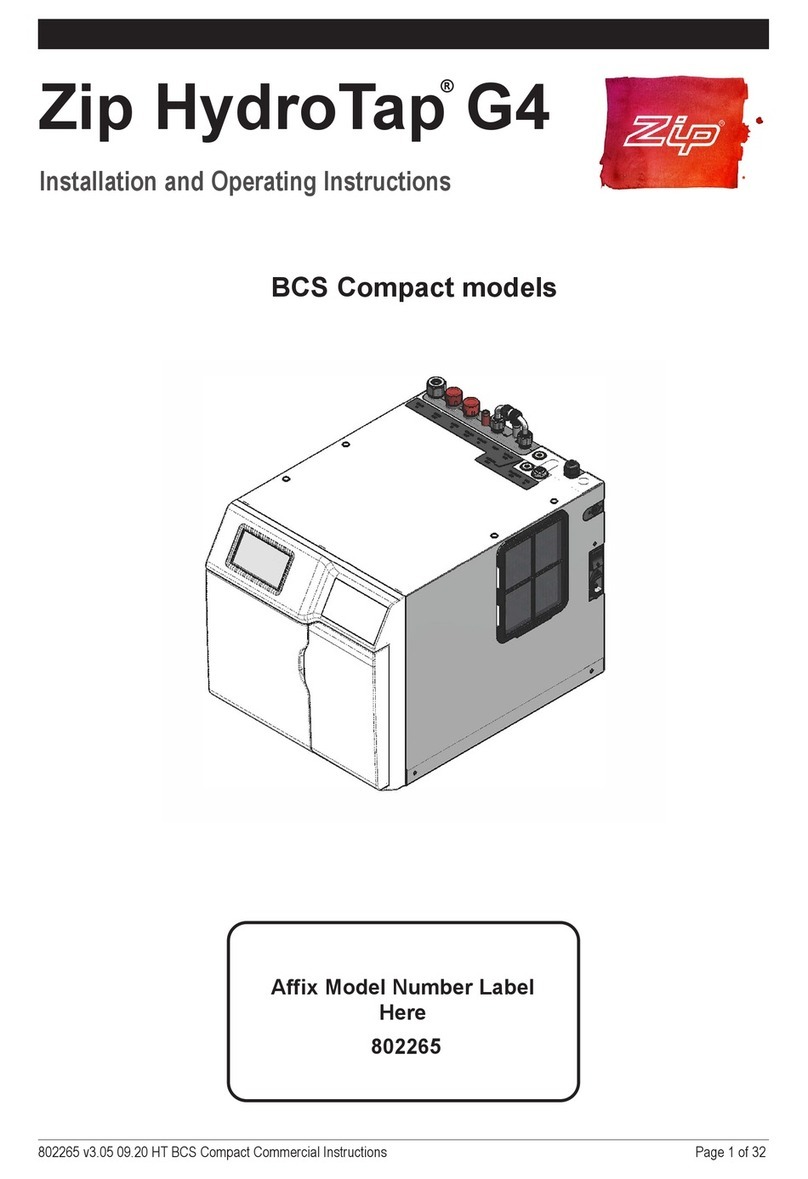
Zip Water
Zip Water Zip HydroTap G4 BCS100/75 Installation and operating instructions
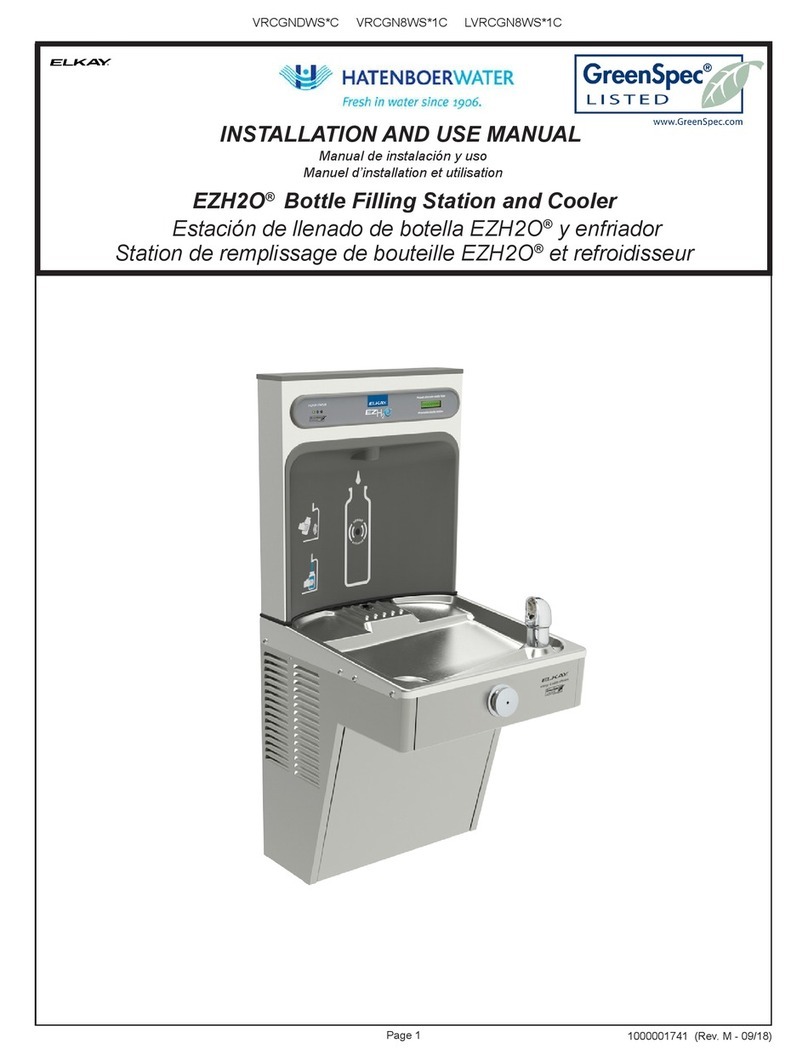
Elkay
Elkay HATENBOER WATER VRCGNDWS C Series Installation and use manual

aero-stream
aero-stream AS500-3 Operator's guide
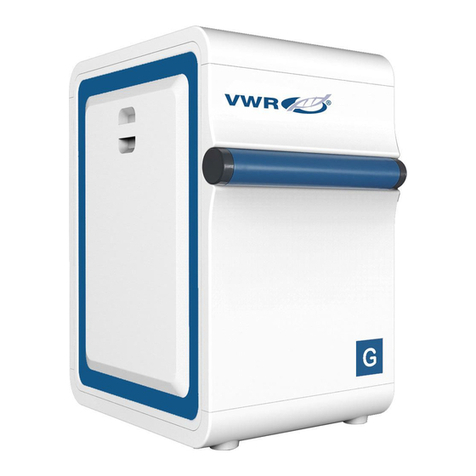
VWR
VWR Avantor G5 instruction manual
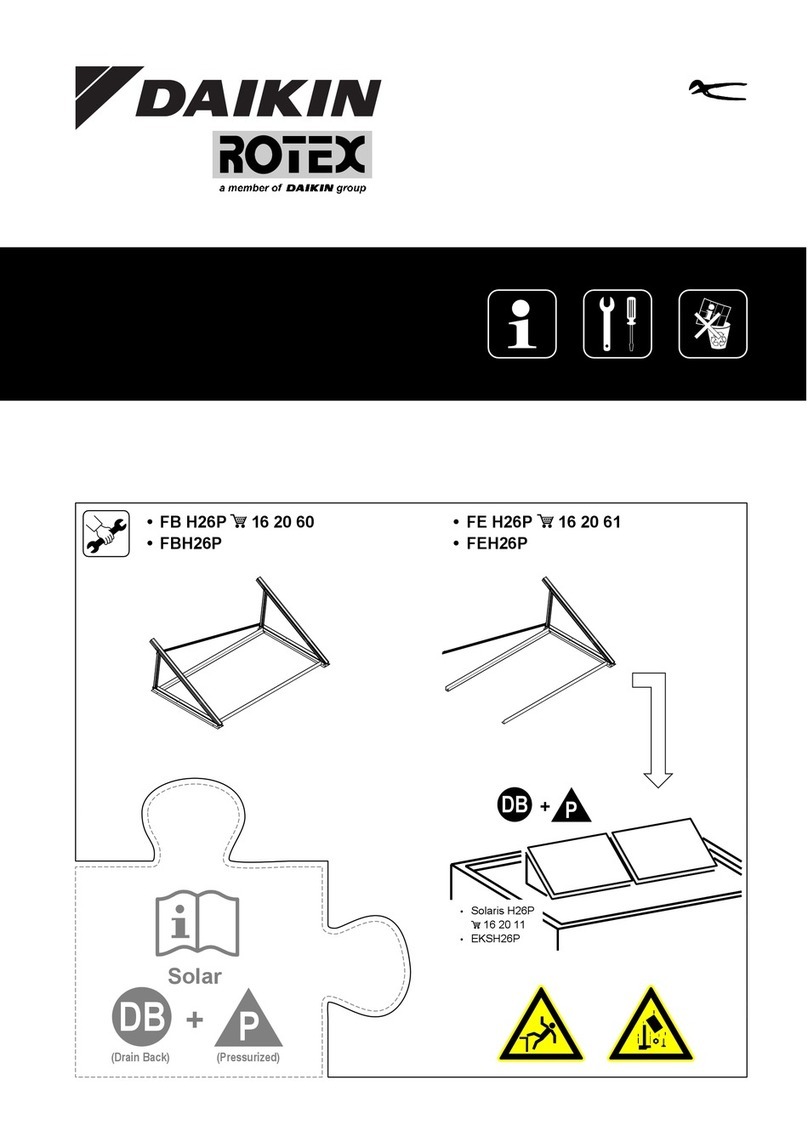
Daikin
Daikin Solaris EKSH26P quick start guide
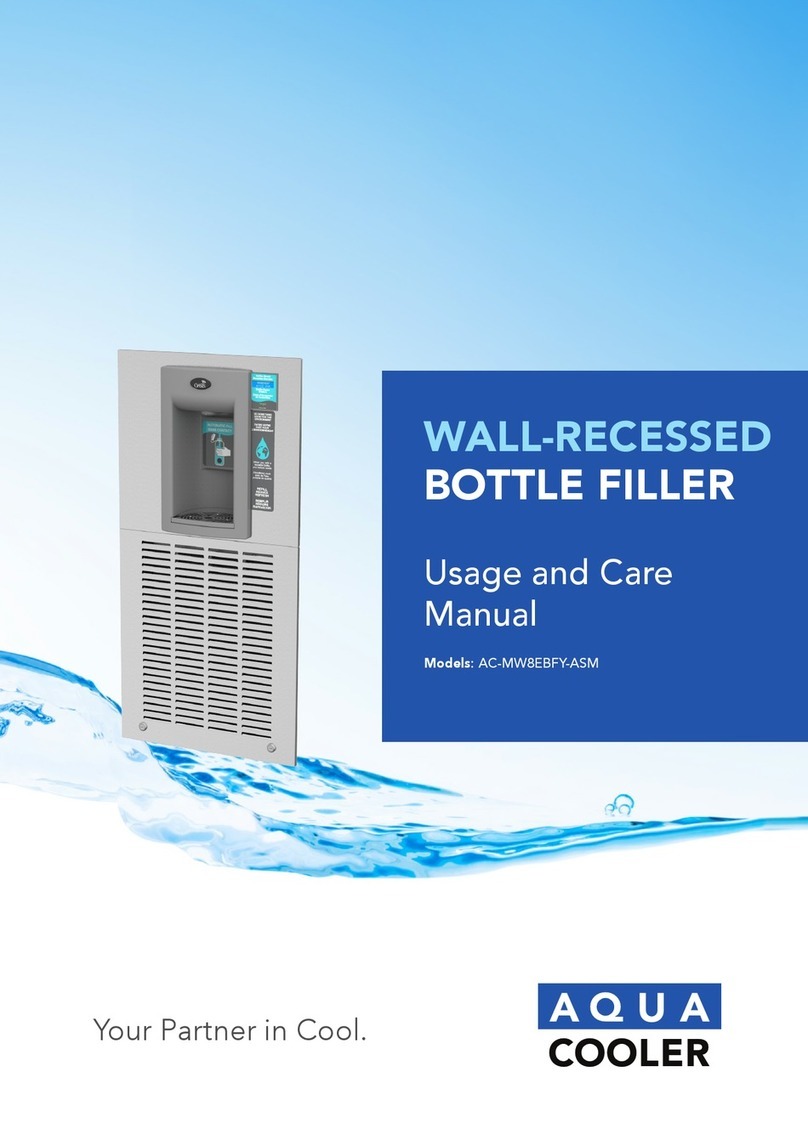
Aqua Cooler
Aqua Cooler AC-MW8EBFY-ASM Usage and Care Manual
